Neonatal IntensiveCareUnit for Foals
neonatal unit for horses may sound farfetched, but one exists at New Bolton Center. ln the Spring of 1984, the climate controlled, separate unit was opened and its staff has been busy every since.
"Newborn foals are very delicate," said Dr. Wendy Vaala. a lecturer in medicine at the University of Pennsylvania's School of Veterinary Medicine whose primary interest is pediatrics. "They are susceptible to many diseases and if they are iU, they need specialized intensive care and treatment which this unit provides. .,
The breeding and raising of horses is a multi-million dollar industry. Each foal is carefully planned to enhance a bloodline. "Most of the horses we see are destined to be athletes," Dr. Vaala said. "When a sick foal is brought here, we not only have to think about the treat-
ment, we also have to consider whether the animal can be an athlete two or three years hence or whether the illness will affect it permanently. That often is very difficult. We have a little more leeway with fillies, colts though must be outstanding; for both there can be no lingering effects of neonatal illness.,.




The greatest number of patients admitted to the unit are foals with septicemia, a bacterial infection which either can be general or localized in an organ or a joint. One of the most dreaded sequela of speticemia is meningitis and for this the prognosis is poor. A newborn foal is exposed to bacteria the minute the birth process begins but nature has devised a system to fortify the newborn animal against these organisms: colostrum.
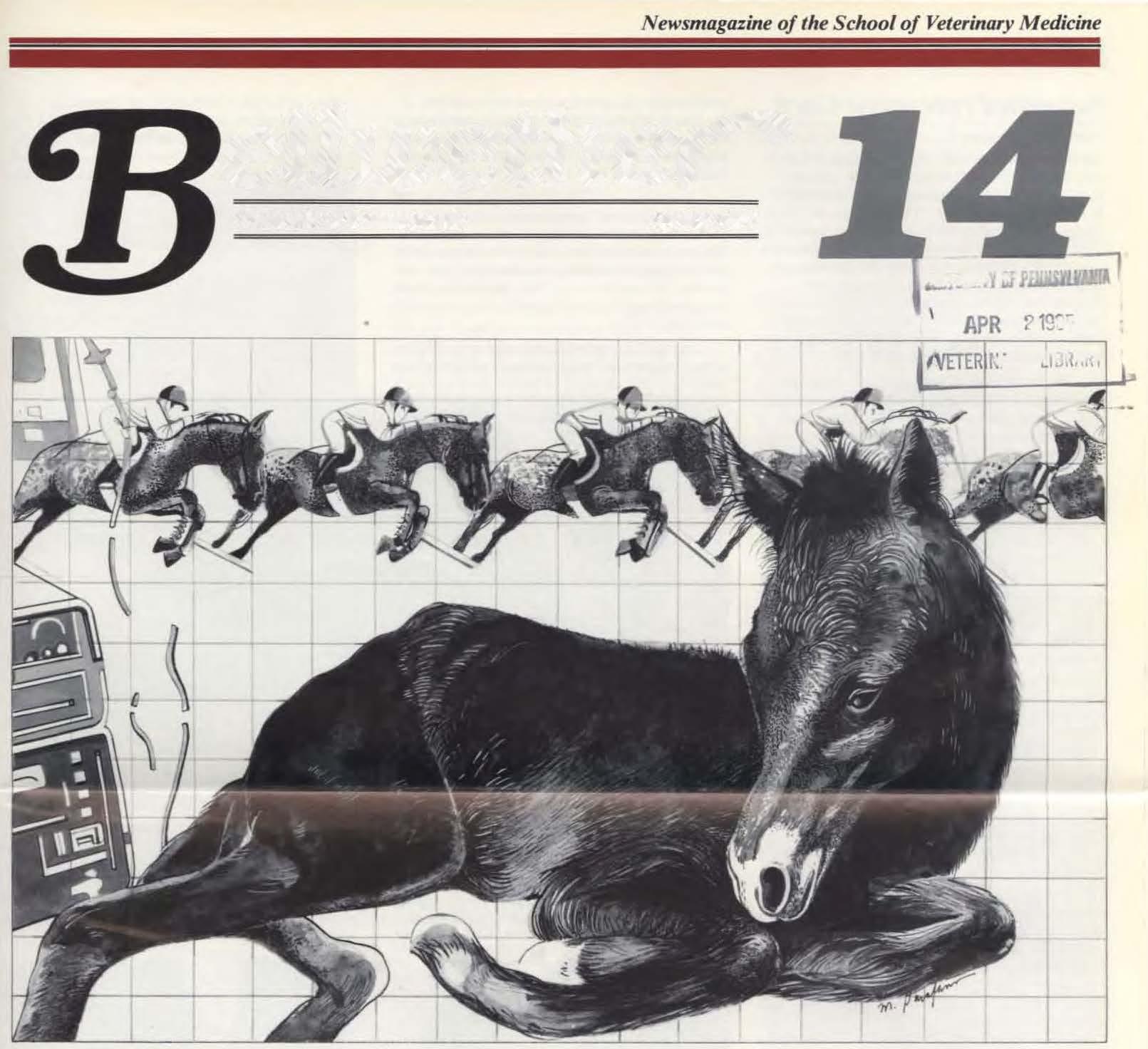
"A great number of septicemia cases can be prevented," Dr. Vaala said. "It takes careful supervision of the foaling and close monitoring of mare and foal for at least a week after birth."
She explained that a mare should not be shipped during her last four weeks of pregnancy. ''This gives her time to develop antibodies to organisms in her environment... she said. "These antibodies are concentrated in the colostrum during the last three weeks of the mare's term. lf the environment is changed shortly before btrth, the mare won't have time to develop the proper antibodies, leaving the foal vulnerable and unprotected." According to Dr. VaaJa, the pressures of the horse industry are such that breeders frequently have to ship mares shortly before giving birth so that tbe mare can be bred again as quickly as possible.
Dr. Vaala pointed out that generally a healthy. strong foal is not susceptible to septicemia but that weak animals quickly succumb to it. "If a foal has a difficult birth or if it is premature, it may not be able to nurse right away, so it won't get the colostrum." she said. "Premature foals continuedonpage 2
ellwetherUniversityofPennsylvania Spring1985 ..
NeonatalIntensive Care
cuminued frompage I arc at great risk � there may be no colostrum or very linle of it." She emphasized that newborn foab must receive colostrum shanty after birth in order to be protected. "There is only an 18- to 24-hour period after binh in which the animal is able to absorb the antibodies from the colostrum into its bloodstream.After that the gut changes and the large antjbodies can no longer pass directly into the foal's system.This brief period can be shonened funher if the binh was a difficult one, then steroids. released by the foal, will hasten the change in the gut."
Dr. Vaala said clo e supervision and obser"ation during binh can avoid potential septicemia "If it is known that the foal cannot nurse then other steps can be taken to give it the colostrum." she said. "The veterinarian can tubefeed the colostrum." Sometimes it appears that a foal is nursing, though examination of the marc reveals that the foal w� just nuzzling, such foals too need tubefeeding. Dr. Vaala explained that colostrum freezes well and keeps for about a year ..Large breeding farms keep it on hand for foab at risk (i.e. premature.weak or orphan foals) and we have it here at New BaiLon Center."
She also recommends that all newborn foals be tested for an antibody titer when they are 24 hours old. "That simple blood test will tell
Bellwether No.14 Spring 1985



Bellwnher ispub
/t:�ht•tlhy cht•.\'chool njlelermar.l Meclidm•at the Cni\wsilI'cifPennsylwmia. in£'ooperaticm wilh tilt• University of Pt'llfh1/vama Office
u/ University Reiatiom.
Editor:
llelmu Weeks
Au -i stant Editor:
John£ .\.!arlin, r.\t.D.
Writers:
/Ieima Weeks
Or. \1. Josephine
Deubler
(Animal Cracker.\)
/Jf'.�igner:
RobJanssen
11/u.'ittator:
li.Jam• Garofano
Photographers:
Anthony J.J'c>ud
lrmre R. Klwuln
New Bolton Liaison:
Cmltnine Larmore
Distribution:
June .!ohm
Jti>tilikero hear yourprai:,e. crilici.sm.\, ur commenrl. Please addre.\s !'our correspondence to: Helnw Weeks, Uni\'ersin nf Pennsl·b·ania. Sdwvlof J'eterinafl \ledkine, 3800SpruceSlreet, Philadelplua. PA /9104 orLindaFischer, Uni\·ersily of Penn


.SJ'i�·ania Ojficeof Gniver.\ill Relations. 4/0 Logan Hall. Philadelphia. PA 19104
(115)898·3451
None(ifthewarcidesare tobe reproduced inani'rorm without the• permission of Ihe edilors of Bellwether.
/985 Coprright bythe Trmtee:,of 1/re Umversityof Pennsl'l\'ania

whether the animal has sufficient protection. If the titer is low then the veterinarian can boost it through a plasma transfusion. It i� not an expensive procedure and can save a lot of trouble later."
Sometimes though all these precautions do not help and a foal becomes seriously ill. This occurs frequently with the premature animal. Often such a foaJ is not able co breathe properly and must be given oxygen or even put on a respirator. Recently a foal at New Bolton was kept on a respirator for ten days and then successfully removed from it.
The young patients in the unit require a lot of specialized care. There are tests to be run, cui-
tures to be taken and above all, the animal has to be fed very frequently to keep it alive....A foal consumes 10 percent of its body weight in milk daily." Dr. Vaala said. "This requires careful calculation and frequent meals." An added problem is that newborn foals are very prone to stress. "They can develop gastrointestinal ulcers when stressed, this can lead to internal bleeding or intestinal constrictions. Our nurses are trained to handle these young animals in such a manner as to keep stress to a minimum."
Whenever possible the mare IS brought along with the foal. She bas to be kept near her offspring and has to be able t('l watch it. ''It helps the foal to recover quicker if it is near its dam," Dr. Vaala said. "But we then need extra hands to
2 her
Orphan. 23-dayprema/Urefillyj48hours old; She isrestin�on foam cushions and pillowsand is receiving imravenousfluids lo maimain her hydration and provide nutritwn. Her legsare wrapped to prevem self-trauma.
Thesamepremawrefillybeing encouraged to ,�,·alk, notehow weaksheappears. She can not holdher head upina normalposition. Her tendonsareveryweakand she is unable 10 �1ialk willwuta grea1deal ofassistance.
calm the mare when we treat the foal. We have to make sure that she can see it at all times during treatment, otherwise she may become frantic."
If the mare cannot accompany her foal then a foster mare may be brought in to nurse the animaL "These mares are usually very placid and will accept a strange foal,'' she said. "Though we do have to fool her a bit by putting a scent on the foal and into her nostrils.''
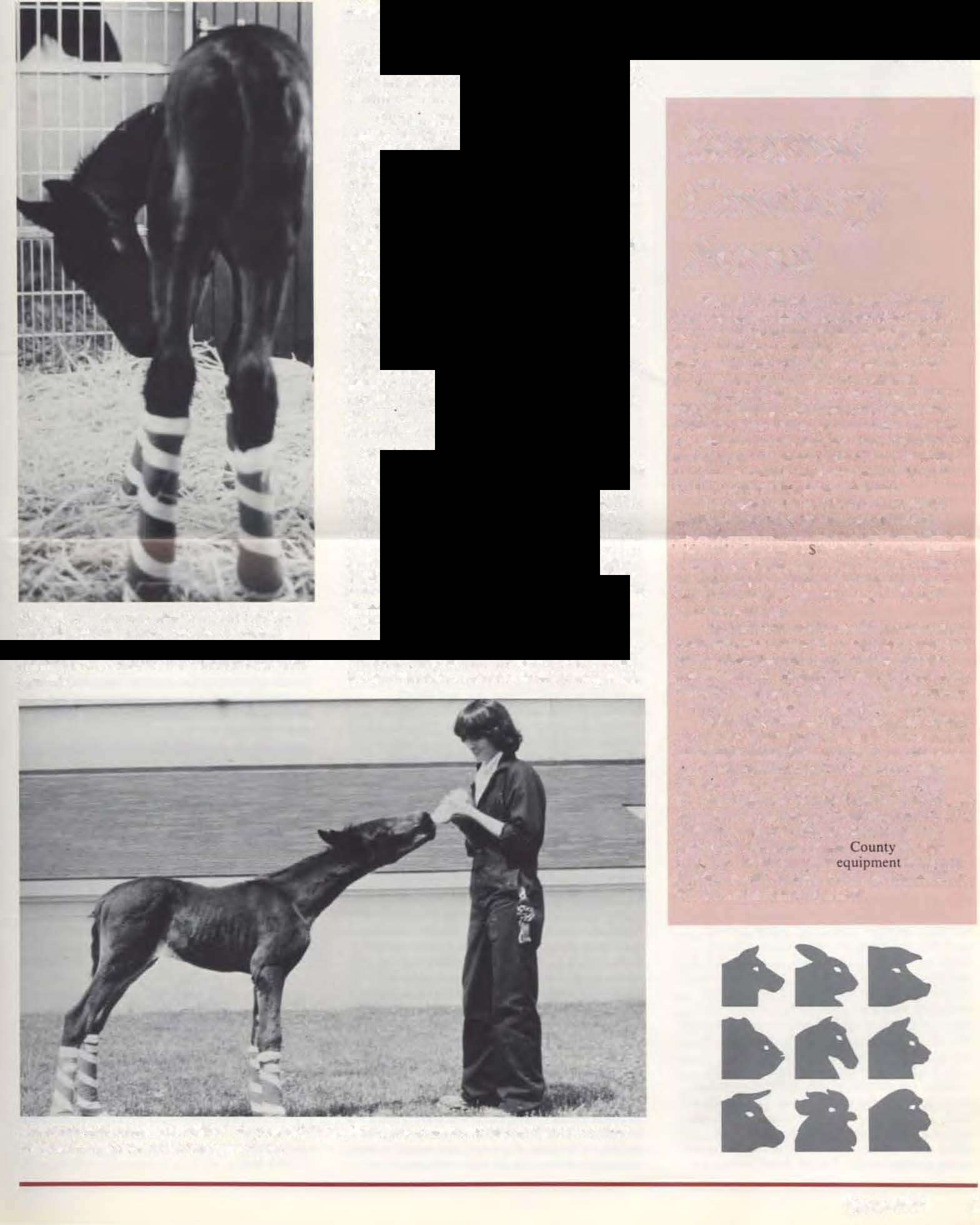
The stay at New Bolton Center for a septicemic foal can be a long one. However. Dr. Vaala explained, owners are willing to spend the time and money to save a valuable future race or breeding animal.
The umt does not only see foals with septicemia. Each year a number of very young animals with botulism are seen. This disease, caused by the toxin of the spore forming Clostridium bacteria used to be fatal. "We now have an antitoxin which can be given to the animal," Dr.Vaala said. "It will not cure the disease but will stop its progress. ·• Botulism causes an animal to be weak and uncoordinated. it cannot swalJow and in advanced case:> the breathing is affected. "Such animals need great care and supportive treatment. They have to be sustained until their body has regenerated the nerve endings affected by the toxin. It is a tong and taborintensive process." The staff at New Bolton works with these foals intensively. They are given physical therapy. they are held in a sling to enable them to attempt to stand and they are carried outdoors if the weather is nice. "We use the resptrator for these animals and we have been able to puU them through," she aid.
The building is being designed by Bohlin Powell Larkin Cywinski and the neonatal unn wiU have three foal stalls and two larger stalls. Construction will begin this year. The building is funded by private gifts and it will be the first structure to be funded by the Second Century Fund.
Helma Weeks

Second Century Fund

Vincent B. Murph}. Jr.. Second Century Fund campaign chairman, reported to the Jan. 16 Board of Overseers meeting that campaign gift�. �ubscriptions and bequests to the end of 1984 totalled $15.337.482 or 37 percent ot the five-year campaign goal of $41.5 million.
Thefllb• can now rise, standandwalk on her own. She has been moved ro the mareffoal stall. A nurse mare has been brought in and is standing in the background behind the movable partition.
Another type of patient seen in the neonatal unit is the "dummy" foal. These foals are normal at birth but within the first twenty four hours they suddenly become disoriented and forgetful. They don't nurse and they wander around the stall. They quickly weaken and require intensive care...It IS beheved that this condltton, neonatal maladjustment syndrome, is caused by oxygen deprivation during birth,'' she explained. "Brain cells die and this causes the foal's behavior. If the damage is not too severe, these animals can be saved through intensive supportive therapy."
The neonatal unit at New Bolton Center is small but plans to build a larger unit as pan of the new intensive care unit are being completed.
Among the major ne"' gifts reported was a $325.000 challenge grant from the Mabel Pew M)rin Trust for laboratory reno\ations for the Department of Pathobiology. Under the terms ol the grant. the Veterinar) School must raise the same amount from other new :>Ources by Sept. I to receive the challenge committmcnt.
The School also received an unrestricted distribution of $129.324 from the Estate of Alfred Roo;enthal. and we were informed that an m!llCal dL..,tnbution of I00,000 trom the State of Judith A. Sankev would be made to endov. a memorial research fellowship •·relating to the care of the diseases affecting dogs and other domestic animals."

The Mrs. Cheever Porter Foundation made a $10,000 grant toward the proposed Contagious Disease Isolation Unit at New Bolton C,enter, and the .Janet A. Hooker Charitable Trust mad�: two gilts totalling $15.000 for research in kidne) dise�e and neurological disorders in dogs.
Other gifts included $3,149 from the American Shetland Sheepdog /\ssociation for research into Sheltic Skin Disease: SI.OOO from the j\\orv..ich & Norfolk Terrier Club for the Canine GenetiC Disease Information System: $2.000 from the Delaware County Kennel Club. PA. for equipment in neurology; $1.000 from the Chester Valley Kennel Club, PA. for the scholarship fund: $1,000 from the Bucks Count\ Kennel Club. PA. for the hospital equipment fund: and Sl.500 from the Rockland County Kennel Club, �Y. for canine genetic research.
A nurse is boule-feeding rhefillyduring one of her walks. She can walk and trot on her own and is ready lObe sent home with her nurse mare.
Spring1985 3
BeautifulBut Dangerous
Plant Poisoning in Pets
leander. with it'sflowers of white, pink, red and violet, adds beauty to many surroundings, both indoor and outdoor. It may also be lethal. Like a number of other house or ornamental plants, oleander combines outward beauty with the presence of toxtc principals. ln the case of oleander, tbe leave� contain a cardioactive glycoside, oleandnn, sirmlar in action to digitalis, but more persistent in its action, and therefore more toxic. A stngle oleander leaf may be fatal when consumed by children, pets, or farm animals. Fortunately, the green leaves are bitter tasting, and it is unlikely that pets such as puppies and kittens will eat them.However, dried leaves may be eaten in playfulnessresulting in poisoning, marked by vomiting, diarrhea, rapid breathing, and various disturbances of cariac thythm.
While plant poisoningin pet animals is less commonthan inlivestock. it can pose a perplexing problem forthe animal owner and the veterinarian. The increasedcultivation of houseplants and outside ornamentalplants has heightened the risk of poisoning in children and pets. For many years, aspirin was the leading cause of poisoning in children, but with the advent of safety closure caps the incidence of toxicity tothis common drug has decreased, and today. bouseplants are the most frequent agentinvolved in pot::.oningof cluldren under five year:. of age. Dunng the penod 1979-1981, the Animal Poison Control Center at the Universuy of illinois reported thar 11.6 peiCent ofall phone inquiries were related to plants, and 50percent of these involved poisoning in dogs, cats, and caged birds.
Wblleplatapoisoningh1.peta11inullstsless commonthanInlivestock,itcanposea perple.\.'ingproblemfortbeanmuuowner atJdthet'eterhaariaJJ.



Older dogs and cats are not likely to eat plants. but puppies� and to a lesser extent kittens, may as a consequence of playfulness or boredom mouth anythingwithin reach. including plants. Occasionally, a well meaning owner will feed caged birds seedsfrom wild plants, leading to poisoning. There havealso been cases reported in which pet animals have been deliberately fed hallucinogenicplants.
Various toxic principalscomained in plants arc responsible for poisoning. These include alkaloids, polypeptides and amines. phenanthrene compounds, glycosides, oxalates, resins and resinols, and phytotoxins. Livestock. which have long been exposed to these agents have developed elaborate detoxifying systems which offer�orne protection against poisoning, but pet animals have no suchprotective mechanisms. and are therefore more vulnerable.
In addition to oleander. some common house or ornamental plants involved in poisoning of pets are: Preca1ory Beans. These colorful beans are illegally imported to make necklaces and rosaries, and theingestion of beanson which the seed coat hasbeen cracked can cause l>cveregastroenteritis. Castor Bea11s, which are
used for the commercial production of castor oil. Castor bean plants are sometimes grown as ornamentals, and theingestion olseedson which the coatingis broken, as happensat maturity, can causepoisoning in pet animals.
OlderDogsa:mlcatsare1101likelytoeat plants,butpuppies,andtoalessere.vtetJt llitterrs,mayas a co"sequ.tmcenJplayfulnessorboredommo111bmrytbbrgwtlbin reaclJ,i11cludlngplants.
The toxic principal isricin which produces profusehemorrhagic diarrhea, possibly convulsions, marked thirst, and abdominal pain. When the plant is used asan ornamental, it is advisable to snip off theflowering head to guard against ingestion by pets. Prunas Species. which includes several varieties of cherry, apple, apricot. and almond trees.The seeds, twigs andbark of these trees containa cyanogenic glycoside, which when hydrolyzed. producescyanide. Livestock may be poisoned by eating wilted leaves, and dogs feeding on garbage or on the res1due from cider production may suffer acute poisoning. Cases of toxicity have been reported in dogs eating the bark of cherry trees, and pet birds have beenpoisoned through eating apple seeds. Poisoning runs a rapid course, with death occuringin oneor two hours. orsooner. Clinical signs include excitement. followed by depression. incoordjnatioo, and convulsions. Blood of pojsoned animals is an unnatural bright red. Netlies. which include the stinging nettle, and bull neltle. These have hairs which when rubbed off the plant release acetylcholine, acompound which stimulates theparasympathetic nervous system. The most common typeof poisoning is observed in hunting dogs which encounter the nettles in marshyareas. Clinical signs include excessive salivation, irritation of the mouth. leading to frequent pawing, muscular weakness, and tremors, In 1963, a fatal case of poisoning due to the bull nettle was reported in a six-yearold child in thePhiladelphia suburbs. Poison lvv. whose toxic principal, an oil resin, may be carried on thecoat of animals and result in poisoning in humans. Apparently animals do not
exhibit lhe severe allergenic response seenin man.
These are a few plants which havebeen involved in reporterl poisonings. Thereare a number of others whichare potentially toxic including caJidium, foxglove, lily of the valley, snowdrop and iris. For those interested in furtherinformation, Dr. Murray E. Fowler. School of Veterinary Medicine, University of California atDavis, has prepared a detailed bro· chure titled "Plant Poisoning in Small Companion Animals."This is published by the Ralston Purina Co.. Checkboard Square, St. Louis, MiSsouri, 63188.
Many of theplants involved in poisoning of pet animals induce vomiting after ingestion, and this reduces absorption of toxic principals. However. in all cases of suspected poisoningthe pet owner should call his/her veterinarian and attempt to specifically identify the suspected plant.
Students in theSchool of Veterinary Medicine receive a thorough indoctrination in the toxicology of plants. The course is under the direction of Drs. David Kowalczyk and AraDer Marderos1an, and instrucllon includes a visit to theJenkins Arboretum. examination of 600 slides showing poisonous plants. viewingvideotapes of actual cases of plant poisoning, and leelures. The slide set used for instruction is considered to beone of the best in the country. Students are required to indetify fifty-five poisonous plants and have knowledge of therr poisonous principals, clinical signsof toxicity. and treatment of poisoning.
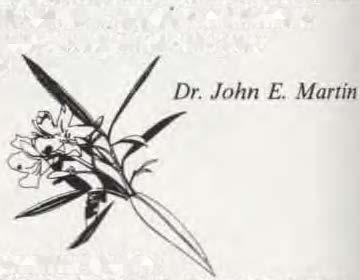
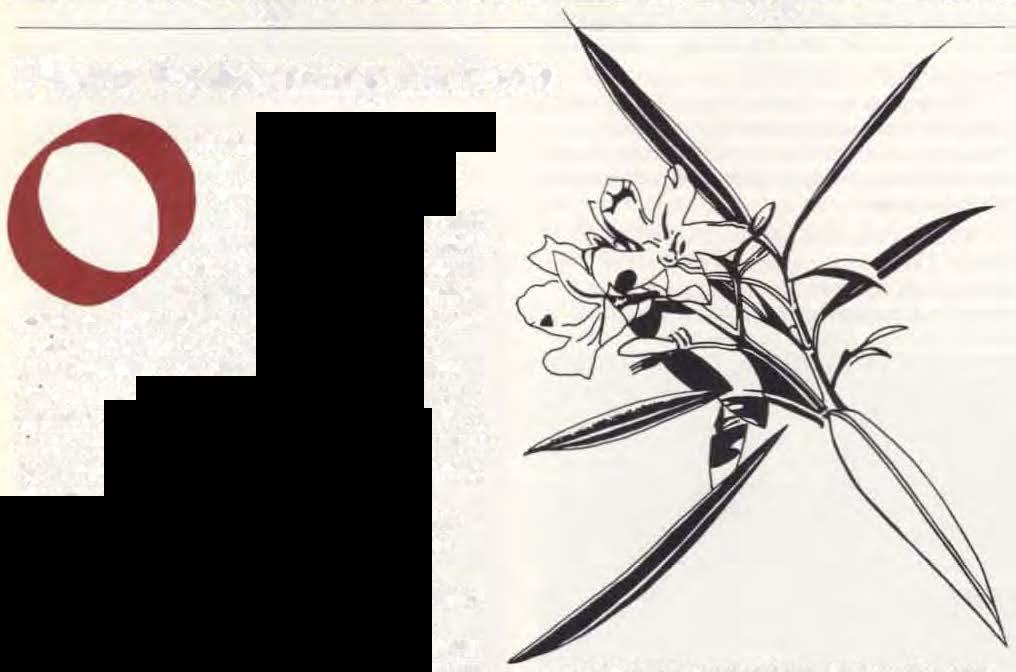
TheJenk.ins Arboretum, located inTredyffrin Township. not far from the De'on Horse Show Fairgrounds, is a unktue factlity of founysi>. acres. It is divided into sections. each of which have beennumbered on a map and identified with the types of plant located Ln each plot.
Casesofto:dcityhavebeenreportedindogs eatingthebarkofcherrytrees,andpet birdshavebeetrpoisonedthrougheadng appleseeds.
Over seventy toxic plants are found at the Arboretum which is open to the public Wednesday throughSunday. For information,call Mr. Leonard Sweetman, (215)647-8870. The slide set used by students in studying plant toxicologyis also available for public use. Call Dr. David Kowalczyk, (215) 898-6503.
As is the case with all potentialpoisonous materials. keep house plants and seeds out of the reach of small children. pupptes and kittens. When poisoningis suspected, call your veterinarian!
PoisonInformation Hotline
AnAnimal PoisonControl InformationCenter has been established at the University of lllin01s. It provides antidotal and other information ona 24-hour basis. 1t is staffed by veterinarytoxicol· ogists and can be reached by calling 217-333-3611.
4 Bellwether
Swine Tuberculosis
illions of dollars are lost annually by American farmersand lhe meat packing industry because meat from a large number of slaughtered pigs cannot be sold as roasts, chops or hams. Instead many carcasses must be cooked prior to processing or they may even be condemned. The culprit: swine tuberculosis.
Researchers at the University of Pennsylvania, New Bolton Center, found that the disease, called swine tuberculosis. is minimally contagious in swine herds. "Swine tuberculosis has great economic impact," said Dr. Robert H. Whitlock, professor of medicine at the School of Veterinary Medicine, University of Pennsylvania...Actually what is called swine tuberculosis is not a tuberculosis in the traditional sense. lnstead, these animals have lesjons caused by Mycobacterium avium, an organism which causes tuberculosis in poultry and wild birds. The swine are healthy and show no clincial signs of disease. When the animals are slaughtered the meat inspector finds the lesions."
M. avium infection is swine causes lesions indistinguishable from those caused byM. JUbercu/osis (TB in humans) orM. bovis (TB in cattle). Swine are susceptible to all three infections and, if they contract the latter two, will often show clinical signs of disease.
An experimentalswine TB lesion

17ze swelling behind the ear denotes apositive skin test
Pathology. The serological results were published in the U.S. Animal Health Proceedings. The researchers concluded that the spread of M. avium by contact is minimal. They then investigated whether the disease could be transmitted from darn to offspring. Sows of different ages were incolulated with M. avium and then
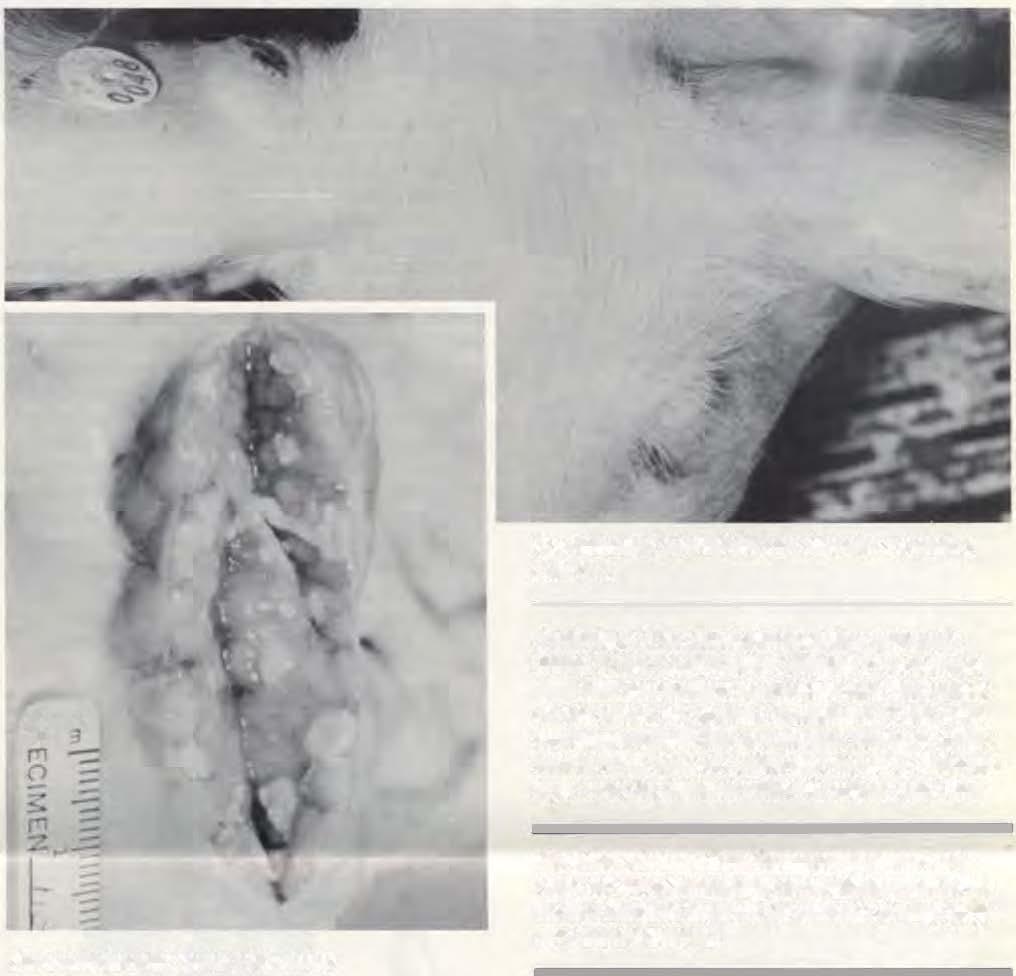
Healso�thatfarm�notusesaw� dustorwoodshaving5asbeddingmaterial inthefarrowhousesorwhereyoungpig5 arebeingraised.
Dr. Whitlock explained that tuberculosis lesions caused byM. avium in swine are not infectious to humans in general, though there may be some danger to individuals with a compromised immune system. AIDS patients often have mycobacterial infections as complications of the primary disease. "On gross examination Lhe lesions of swine TB cannot be distinguished from those caused by, for example,M. tuberculosis. Therefore caution is necessary. The meat is cooked if lesions are found in two body cavities. This, unfortunately, reduces the value of the carcassby 50 percent. If lesions are found in three body cavities, the meat is condemned, causing a total loss...
Pennsylvania is among the top three states with losses due to swine TB. It was found by a Bureau of Animal Industry (Pennsylvania Department of Agriculture) investigation that themost frequent agent causing the infection in this state wasM. avium sereotype 4. Mycobacterial agents in many forms are present in the environment and there are many sereotypes of M. avium. The organisms are very resistant to temperature changes and can survive a long time insoil,water and beddjng.
Researchers at the School received support from the Pennsylvania Fair Fund (Grant #tM-44) and the University made additional funds available to initiate a study to determine the age susceptibility of swine, the pathogenesis of infection in piglets, and whether the disease is spread by contact and whether it can be spread to offspring of infected sows.
Piglets in age groups four, eight, 12, 16 and 20 weekswere inoculated with M. avium sereo-
type 4. A control group of pigs of the same age was also kept. These were not infected. The two groups were kept apart for four weeks and then allowed to mingle. Blood samples were taken from both groups at regular intervals and the animals received the intradermal skin test for TB. The pigs were slaughtered at market weight (about 230 pounds). At time of slaughter blood was drawn for an ELISA test.
M.avtuminfectioninswinecauseslesions indistinguishablefromthosecausedbyM. tuberculosts(TBinhumans)orM.bovls(1V incattle).
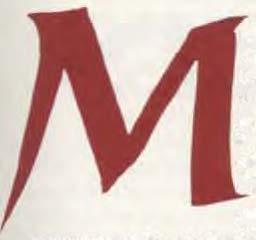

Researchers found that the pigs inoculated withM. avium showed a pos16ve reading to the skin test six weeks after the infections. The control group did not show any positive results to the skin test. Positive readings forM. avium infection in the inoculated animals occured in the ELISA test at about eight weeks after infection. The control group, which had mingled with the infected animals, did not show positive results of the skin test nor could the ELlSA test detect any antibodies toM. avium.
After slaughter, the pigs were inspected for Lesions. The most severe were found in pigs who had been infected at age eight weeks. The lesions were less serious in the animals infected at a later age. No lesions were found in the control group. The results of this portion of the research will be published in the Journal ofComparative
bred. The animals and their offspring were examined after slaughter and it was found that the sows had very minimal lesions and that the piglets bad none. "Farmers can buy older sows as breeders, even though the animal may test slightly positive on the skin test," said Dr. Whitlock. "The danger of transmitting the disease to the offspring is minimal."
Researchers then examined some herds with a high incidence of swine TB. It was found that these animals were kept on sawdust or bark shavings. Other researchers had discovered that this material frequently contains a high concentration ofM. avium. "When the bedding material was removed for a new group of pigs the incidence of swine TB in that herd dropped to zero."Dr. Whitlock said.
He advocates the use of the ELISA test to determine whetherswine are infected withM. avium. "This test is more accurate than the skin test. Unlike the skin test, it could provide indication that one is dealing WithM. avium and not one of the more dangerous forms of mycobacterial infections. He also advises that farmers not use sawdust or woodshavings as bedding matenat in the farrow house or where young pigs are being raised. Further he recommends that facilities in which pigs. are housed are regularly disinfected and that contact between pigs and poultry or wild birds be minimized.
Drs. Helen V. Acland, Robert Eckroade, Jeffrey I. Everitt, John Dick, Wes Wilcox and Robert H. Whitlock cooperated on this project.
Helma Weeks
"Actuallywhatiscalledswinetuberculosis isnottuberculosisinthetraditionalsense.••
C/) n ""0 8�-,., :::
Spring 1985 5
American KennelClub CentennialShow
TI1c largest DogShowin theWesternHemispherewasheldinNovemberin Philadelphiaas partoftheA.K.C.'sCentennialcelebration. Therewere8.075dogs. represenung l4J different breedsorvarieties,entered.Thelargestentry was214 DobermanPinschers,followedby207 SiberianHuskies. l991rishSetters, 181 Dalmatiansand 177Borzois.BestinShowwasaGermanShepherd Dog,Ch.CovyTuckerHills Manhattan.
ThiswasthesecondshowheldbyA.K.C. Thefirst wastheSusquicentennialShowin1926. Atthatshow,only83breedsandvarietieswere represented.Almost50''new"breedshavebeen acceptedforcompetitionsincelhatshow,and somebreedsshownin1926arenolongerrecognized(MaremmaSheepdogs,Chinese-Crested, Owtchar.� Eskimo,MexicanHajrJess)
Themostrecentadditionstothelistof breeds eligibleforcompetitionatA.K.C.shows arethe PharoahHound,PortugueseWater Dog andTibetanSpanieladdedin 1983
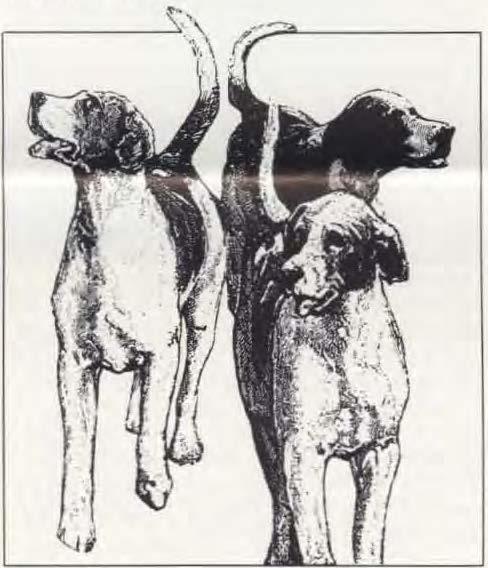
Thereh.avebeensomenamechangessince 1926. RusstanWolfuounds.firstregisteredin 1891.becameBorzoiin1936. Registeredoriginallyin1934asBrittanySpaniels.thisbreed clarifieditsstatusbydroppingLheword"Spaniel"in1982.TheStaffordshireTerrierbecame theAmericanStaffordshireTerrierin1972and JapaneseSpanielshadtheirnamechangedto JapaneseChinin1977.
TheAmencanKennelClubhasgrown tremendou5lyinitsfirst100years.In1886.thefirst fullyearofitsexistence,1,896dogsof26breeds wereregistered. In1885,therewere I1 all-breed dogshowsheld. In1983.over10,000eventswere heldbynearly3,000clubsacrossthecountry.

Pure-Bred Dogs/AmericanKennelGazette, populorlycalledtheGazette,hasbeenpublished withoutinterruptionsinceJanuary1889. ItpublishesactionstakenbyA.K.C.• listsdatesfor shows.obediencetrialsandfieldtrialsasweUas thejudges.andcontainsmanyinterestingand informativearticles.

WeallwishtheAmericanKennelClub anothercenturyofprogress.
TrainingYourDog.
There havebeenmanytheoriesadvanced andmanybookswrittenabouttrainingdogs. The..average"dogownerwillenjoy Dog 1tainmg Made Eas_1 byMichaelTucker(Rowell BookHouse. NewYork.$17.95).1tcoversselectmgacompaniondogandteachingittobeobedient,happyandtrustworthy. Theauthorhasa dog-trainingschoolinAustraliaandspecializes indealingwithproblemdogsaswellastraining procedure11.
Theauthorsaysthatexceptforasmall minoritywhichhavereachedthepointofno
return,mostdogscanbetrainedtohavetheir faultscorrected.Theownerneedstobetrained withthedog.Thebreedshouldbeconsidered carefullyandlookatadultdogsaswellaspuppies.1falargebreedisselected, theowner'sabilitytocontrolthedogshouldbeconsidered.A puppyshouldgotohisnewhomebetweenthe agesofeightand l2weeks(neverbeforesix weeksofage).Thisisthemostreceptivetimefor ittolearnsimplecommandssuchas"Come". "Sit".and"Heel"Between12and16weeks, puppiesoftentrytogettheirownwayandthisis thetimeitmustlearnthatthemasteristheboss andpackleader.Fromthefourthtoseventh month.thepuppymustgetoutandmeetpeople, otherdogsandthings that happeninthestreet. oryoumighthaveapuppyfearfulofthingsin theoutsideworld.
senseofsmell,hissenseofvisiontakesthird placeandthencomeshissensesoftouchand taste.Adogalsohasasenseofbalance, asense ofheat. asenseofdirectionandanincredible senseoftime.lnaddition. thereisevidence10 suggestLhathecansensethesupernatural. Chapterscovertrainingequipmentand well-illustratedtrainingprocedures,basicand advanced.Thereareanumberoftruestories aboutproblemdogs.
Thisis oneofthebetter booksontraining available. Whileallexpertsmightnot agreeon themethods used,thereaderwilllearnthebasics involvedineducating adog.
GestationPeriod
Inthe dog.theaveragelengthofpregnancy is65days,butisextremelyvariablebecausedog spermcansurviveintheuterusformanydays beforeovulationoccurs.Conceptionsfroma singlebreedingmayresultinapparentpregnanciesof58to71 days.
Averagedurationofpregnancyinotheranimals.
Cat 63-65days
Cow 280days
Mare 330-340days
Elephant 20-22 months
Sheep 145-150days
Mouse 18-20days
Squirre1 44 days
SpermWhale 16months
Deer 200-220days
Goat 150days
Raccoon 63days
Rhinoceros 530-550days
Camel 410days
Alloftheabovearenotexact.Therearevariationsamongbreedsofcattle,muttonandwool breedsofsheep.etc.
ThechapteronPuppy Conditioning emphasizestheimportanceofgettingthepuppy accustomedtothingsthatmighthappeninthe home(strangers,vacuumcleaners.etc.)andin theoutsideworld,includinghowtomeetdogs onandoffleash.
Common Problems areJUmpingup,barking,etc. ftislikelythattheowneristheproblem ratherthanthedog.Whatevertheproblem.itis unacceptablefortheownerbutgreatfunforthe dog.Aprincipleofdogtrainingisthatyou shouldalwaysbeinapositiontopreventorcorrectanywrongmovethedogmaymake. Aggressionmightbepreventedfromdeveloping ifthemaleiscastratedbefore12monthsofage, butislesslikelytohelpinolderdays.
Temperament shouldbesuitedtothedog's work(security,herding,guidingtheblind,dog shows,field trials,obediencetrials,etc.)orits placeasafamilypet.Traitssuchasjealousy,wilfulness,stubbornnessandexcitabilitycanbe overcomewithtraining.
Thechapteron The Dog's Senses statesthat adog'ssenseofhearingcomessecondtohis
EpidemiologyofCancer
Numerousstudieshavefoundthatcancers occurfrequentlyin dogsandcats.Onereport covering asix-yearperiod,shows thatinapopulationof100.000(humans),theincidencewas 272 casesinman.381 indogsand155incats.ln man.themostfrequentsitewas the digestive system,whileindogscanceroccurredmostfrequentlyin thebreastandskin. Thelymphocytic systemaccountedformost casesofcancerin cats.
Inanimals.fewattempts havebeenmadeto identifythecauseincancer. Jnhumans,ithas beenestimatedthat90%ofcancersaretheresult ofen\-ironmentalfactorsand10%canbeattributedtogenetic orviralfactors.Recently. researchersintheSectionofEpidemiologyat theVeterinaryHospitaloftheUniversityof Pennsylvania(VHUP)demonstratedthatexposureofdogstoasbestos inthehomeoratthe owner'sworkplaceincreasestheirlikelihoodof developingmesothelioma,afatalcancerofthe
6 Bellwether
lungorabdominalcavity.
These same epidemiologists areconducting astudy of 150dogs with breastcancerin order toidentifydietary factors,drugs, or otherexposuresthat mcrease the1r risk ofthisdisease. The ultimate goal is to find adiet that willdecrease thechances ofdeveloping breast cancer,especially in older, unspayed females.
Canine bladdercanceris anotherdisease receiving the attention ofthe epidem1ologists at VHUP. More than 100 cases have been diagnosed by the biopsyservice. Preliminary findings suggest that the terrier breeds, particularly the Scottish Terrier, are more prone to bladder cancer. The Keeshond also appears to be at increased risk.
lffunds can be collected, a bladdercancer study could be started. The objective would be todetermine why certain breedsare at increased risk and ifthere is any associationwitha previoushistory ofurinary tract infection. The research also would focus on exposure to specificchemicals in the home and neighborhood tbatcould be related to developmentofbladder cancerin a susceptible breed.
This is one ofmany projectsforwhichsupport isneeded. Interested personsmaycontact Dr.Josephine Deubler at 215-898-8862.
BookReview:
Bird Owner's Home Health and Care Handbook
Gary A. Gallerstein, D.V.M.
Rowell Book House, Jnc.
230 Park Avenue
NewYork, NY 10169
Hardcover. 292 pages, including index with generousblack and wh1tephotographsand line drawings, plus four pagesofcolor plates illustratingnormal and abnormal droppings.
Price: $17.95.
The text is well organized. beginning with theselection and purchase ofanew bird, and


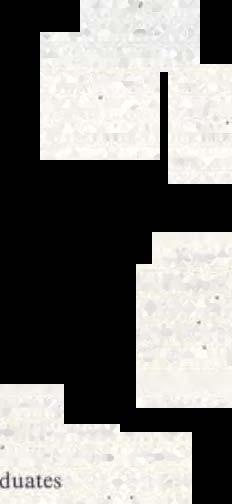



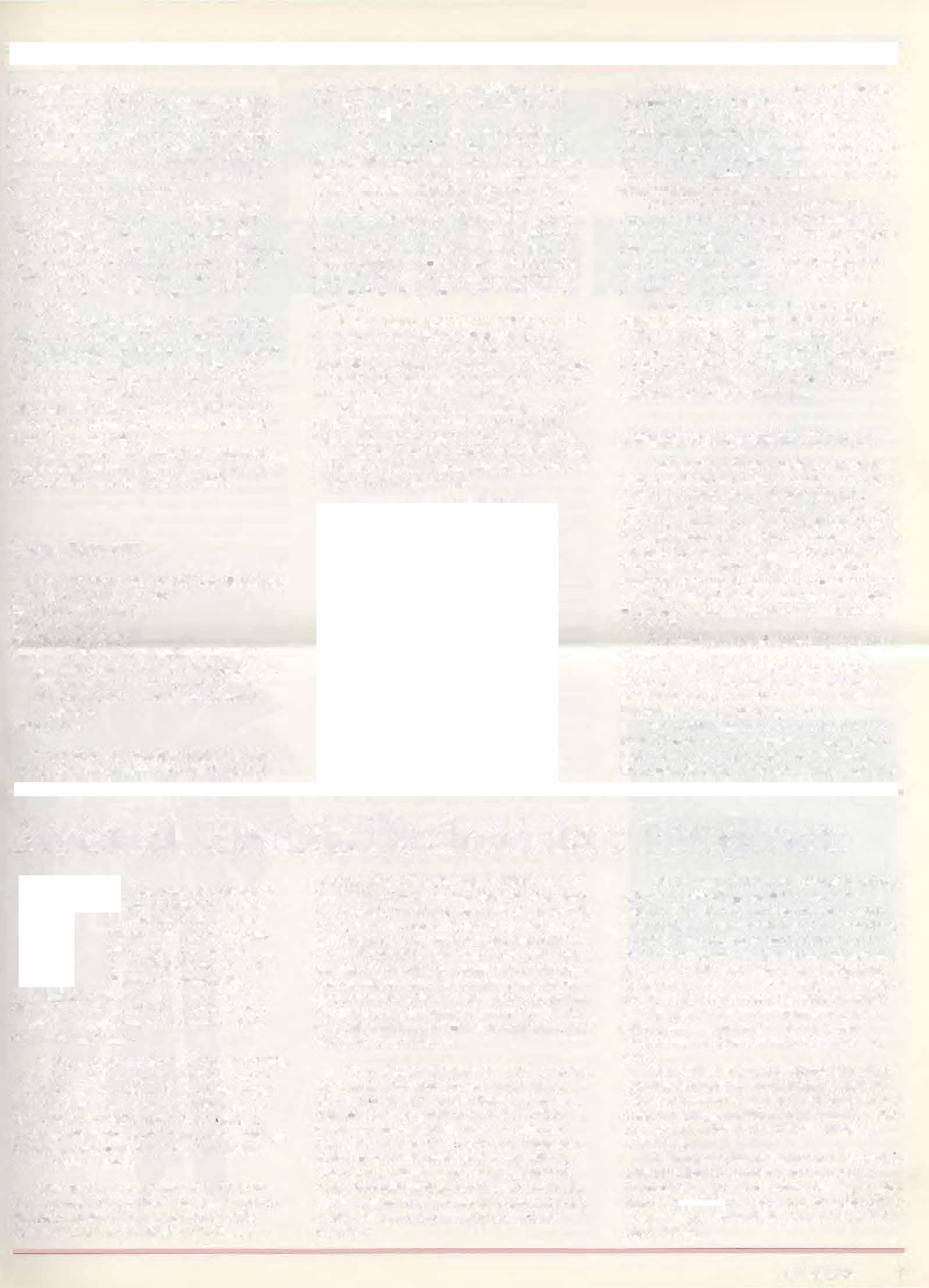
carries through husbandry practices, such as appropriatediets, cages,environments, and acceptabledisinfectants.
Thesection on anatomyand physiology gives a briefdescripuon ofeach organsystem, thenexplains how ownerscanevaluatethe particularorgan system at home- invaluable advice to the owner as well as the veterinarian. Owners will be more attuned to the variations in their birds, more observant ofsigns ofdisease, and more prompt and knowledgeable should a trip totheveterinarian become necessary. Specific diseaseentitiesarecovered, and aspecial index is provided todirect the reader tolocations in the text discussingpartjcular clirtical signs or problems.
Information isprovided regardinga visit to the veterinarian: facilities, diagnostics, and treatment procedures. Inaddition, there are instructions on home supportive care forsickpet and wild birds,especially helpful should aveterinarian not be available immediately.
Avicultural procedures are brieflytouched upon, and a list ofnational and foreign bird organizations isprovided in the appendix. The appendix also contains concisedata with general husbandry and breedingrequirements forthe morecommoncaged birds.
To complete the wide spectrum ofinformation provided. Dr. Gallerstein has included a veryweU written chapter. by Steve Martirt, on "'Tamingand Training Birds... It includes practical suggestionsfortaming, as well as stepsto follow to teach birds specificbehaviors and tricks. There is also asecuon on commonly asked questions regardingbehavior in birds.
This book probably represents the best organized and most generally informative book ofits kind on the market today. Theinformation provided is sufficient to provide novice and experienced bird owners with the background necessary to maintain their birds in optimum conditionsforgood health.
it does not providedetails on thespecific treatment ofdiseaseentities which are best left to the veterinarian. However. the home care measuresdescribed should maximize the chances for recovery should a bird become clinically ill asprompt treatment is morecntical in birds than most other typesofanimals.
DisinfectingwithOorox
Sodium hypochloritesolution is the disinfectant ofchoice to inactivatecanine parvovirus and canine coronavirus. The recommended strength is one part ofClorox to 30 parts water. Usea measuringcup and add a halfcup Clorox foreachgallon ofwater. Do not make astronger solution. Use plasticcontainers. The solution "eats"metal and cannot beusedforsoaking instruments or metal utensils. Clorox in water is used fordisinfecting. For cleaning, a soap solution may be used instead ofwaterto make the l:30 dilution.
Parvovirusesarehighlyresistant to inactivauon. Mostdtstnh:ctuntsare noteffecuve. Virus is found in fecal material for aslong as three weeks after the dog has recovered from clinical illness. Coronaviruses may beshed intermittently formuch long periods.
Prevention dependson a vaccination program. However. when ac:tiseaseis present. special effort is neces�ary toeliminate the virus from kennelsand prevent unnecessary exposure.
Animal HealthTechnician Program
n years ago, the School of Veterinary Medicine and Harcum Junior College. Bryn Mawr, initiated ajoint training program forAnimal Health Technicians. Overthe decade, the program has de\eloped mto one ofthemost successful ones offered by Harcum.and it is the only AVMA accredited pr0.!:,'1'arn for animal health technjcians in Pennsylvania.
Eachvear between60 and 75 srudentsenroll inthesix-semester program whichleads to an associatedegree inscience. Foursemesters are spend in classroom instruction at Harcum in such ubjects as mathematics. basic ciences, anatom). veterinary parasitology. pharmacology, hematology and other subjects necessary for working with animals.
Once theclassroom instructions end, studentsare ready for practical experience. This is garnered during a26-week practicum at the School ofVeterinary Medicine. The Harcum
students spend 13 weekseach at VHUP and at New Bolton Center. At both facilities they work in the wards. theemergency clinic. the operating room. intensivecare unit. radiologyand anesthesiology. They receive hands-on experience in the small anim<tl hospital and in the large animal hospital. By the time thepracticum is over they havecared forsuch diver.c patients asa parrot oramare w1th cohc Throughout the practicum the Harcum studentsarctrained and taught by thestaffnurses at the School. theclinicians, and the founh-year students.
"The animal health technician program has not only benefiued the Harcum students but also our tudents:·saiJ Dr. Sheldon Steinberg, director ofthe program at the School. "The veterinary students. whiJe working with the animal health technician , get an understanding ofthe routine taskstechnicianscan perform, from drawing blood to running sophisticated tests. Our studentslearntodepend on the technicians and they realize that such personnelcan greatlyenhancethe runmng ofnveterinary practice."
n1e Harcum students are trained to usethe advanced technology available here al the School. Though they are also trained to work with e4uipment common!) found at aveterinary practice. Most practitioners do not have automateddevelopmentequipment for radiographs� in practice such film� have 10 bedeveloped by hand. This thetechnictans arc taught. The uajning also includes the latest c1nesthes1a methods and techniques. When the practicum is completed. Harcum students have averygood understandingofthedemands ofa\>eterinary office.
Thegraduates do not have trouble finding jobs. Many practitioners regular}) contact the Harcum CareerCenter when lookmgfortechnicians. Manyoppnrtunities exist m private industry and in government lor the antmal health technicians.
The program.according to Dr. Steinberg, ts asuccessful one, one which provides superb practical tram1ogand classroom training. equjpping thegraduate· Lo work in a profession which is becomingquite -;oplusucated as new technologydevelops.
Spring 1985 7
Dr. E. eil Moore. professorofphysiology, recently published hts fifth book inasmany years. The book. co-edited by Dr.Joel Morganroth.istitled Interventions in the Acute Phase of Myocardial Infarction. Dr. Morganroth is professorofmedicineand pharmacology. Likoff Cardiovascular lnstttute, Hahnemann Hospital, Philadelphia. Dr. Moorealsowasre-electedro theeditonalboardofthe AmencanJournalof Phys1ology and wasasked to beaguesteditor for Circulalion. ajournalmcardiovascularmedicine. Dr. Moorewasoneoftheinviteestoan InternationalSymposiumonCardiacArrhythmiashonoringGordon K. Moe, held inAmelia Island. ln thefallof 1984Dr. Mooreparticipated inasymposiumon the"RoleofProgrammed ElectricaJStimulation in Evaluation of InvestigationalAntiarrhythmic Drugs,"sponsoredbythe IH and the FDA. Heparticipated in the"Symposium on MechanismsandTherapy ofCardiac Arrhythmias,"bythe American CollegeofCardiology heldat Philadelphia. Dr Moore wasco-directorofatwo-dayevent, "SymposiumonNew Antiarrhythmic Drugs and Devices."
Or. ,John T. McGrath (V'43), professorof pathology,known internationallyforhisworkin neurology,presented apaper,"Morphologyand OassificationofBrainTumorsin Domestic Animals"ataConferenceon BrainTumorsin Manand Animalsat the).lationalInstituteof Environmental HealthSctenc�s.ResearchTriangle Park, N.C. inSeptember.Theconference, sponsored bythe �ationalTo;<icology Program/ ational InstituteofEnvironmental HealthServicesand Duke University Medical Center,was attendedbyexperts inthefieldofbrain tumors fromacrossthecountry.
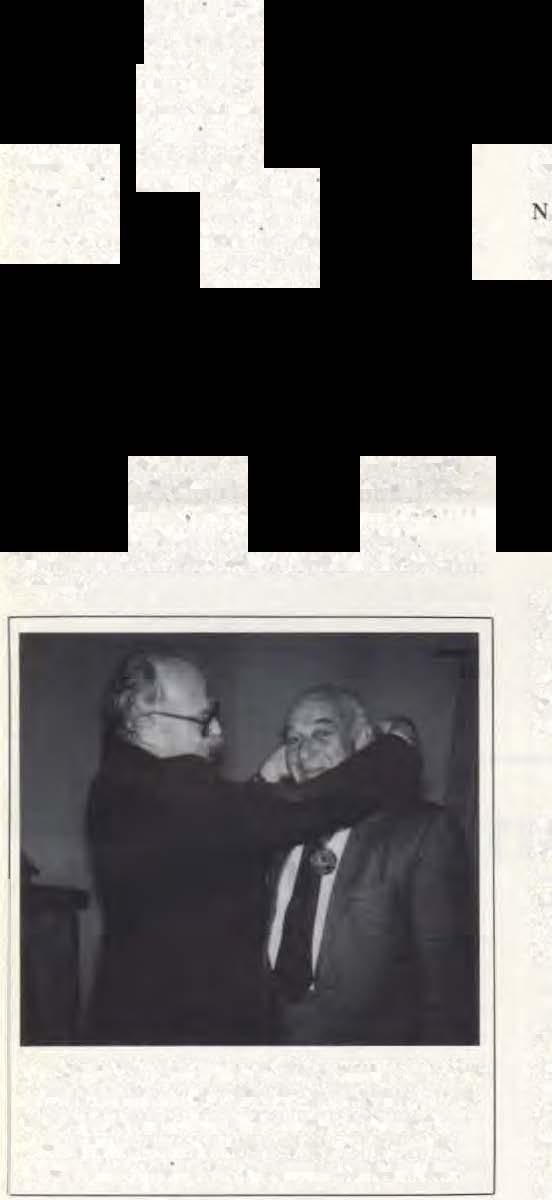

Dr. Bernard Shapiro, associate professorof biochemistry,wasrecentlyawarded a$1,500 grant bythe Pennsylvanja Pork Producers Council. Thegrant istohelpsupport his research on"HormonalCompetenceoftheNaturally Occuringand Experimentally Induced PorcineCysticOvary."
Congratulations tothe foUowingontheir recent promotions: Dr. Carl E. Kirkpatrick (V'81) toassistantprofessorofparasitolo� Dr. Jay Farrell toas ociateprofessorofparasitology� Dr. Michael H. Goldschmidt toassociate professor ofpathology: Dr. !\-lark Haskins (V'69) toassociate professorofpathology.
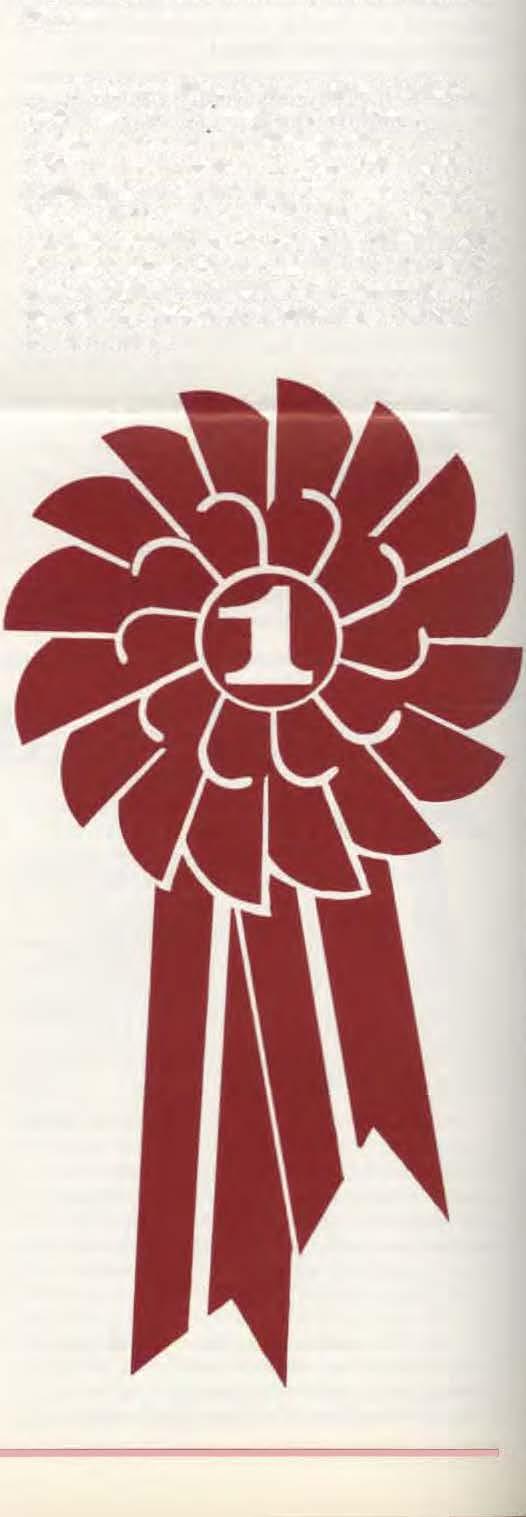
Dr. Susan Donoghue (Y"76), assistant professorofnutrition,ispresident-elect ofthe American AcademyofVeterinaryNutrition. She was recentlyawarded a$100,000grant bythe U.S. Department ofAgriculturetostudy "VitaminA Deficiencyin Pregnancyand Fetal Life."
Dr. Roselyn Eisenberg, associateprofessor ofmicrobiology,alongwith Dr.Gary F. Cohen, School ofDental Medicineofthe Universityof Pennsylvania. will organizethe 12th International Herpes Virus Workshopin Philadelphiain 1987.
OJ. Leon Weiss,GraceLansingLambert ProfessorofCell B1ology.andchairman. DepartmentofAmmal Biology.deliveredthe Fifth Annual Raymond C.Truex Distinguished Lectureshipat Hahnemann UniversityonOct. 26. Dr. Weiss'topicwas"TheSpleen."Dr. Weiss was alsohonored bytheAmerican Medical Writers Association. Hewasselected bytheAMWA astherecipientforexcellenceinmedical publicationsCorhiseditorshipof Histology: Celland Tissue Biology.
Dr. David K. Detweiler (V'42)presents the Centennial Medal to Dr. Marrin M. Kaplan (V'40). Dr. Kaplan who livesandworks in Geneva. Switzerland. was unable to attendthe medal ceremonies durmg the centennialcelebration.
Dr. William D. Hardy, Jr. (V'66), president oftheVeterinary Medical AlumniSociety,was featured on thecoveroftheJune 1984issueof Cancer Research alongwilh two otherveterinarians, Dr. William F. H. Jarrett. Universityof Glasgow, and Dr. Myron Essex, professorof virology, Harvard SchoolofPublic Health.The threemenhavedoneoutstandingresearchintbe field offeli neleukemiavirology. Dr. Hardyis theheadofthe Laboratory forVeterinary Oncology, MemorialSloane KetteringCancer Institute. New York.
Many Kennel Clubs and otheranimal associations support the financialaidprogramfor students byawardingscholarships.Wesincerely appreciatethecontinued supportofthe Burlington County Kennel Club, N.J.,which in 1984 provided twoscholarshipsof$500each. One scholarshipwasawardedto Stephen Wilson, Marlton.XJ..afreshmanstudent;and another to asophomore!>tudent, Wayne Johnson, Lindenwold. N.J. Halfofthemoneyprovided in eachscholarship honors Dr. Linda J. Squires (V'81) whohas provided outstandingservice to theclub as show veterinarian.

Or. David T. Galligan (V'8l), residentin clinical nutrition at New Bolton Center,spoke beforetheNewYorkFarmersAssociationmeetingin Decemberon"Economic Effectsof Ration FormulationonDairy Herdsin Pennsylvania. •·

8 Bellwether
Dr. Henry Schneider (V'34)was named emeritus professorofanatomy at the 1984 commencement ceremonies of Hahnemann University, Philadelphia
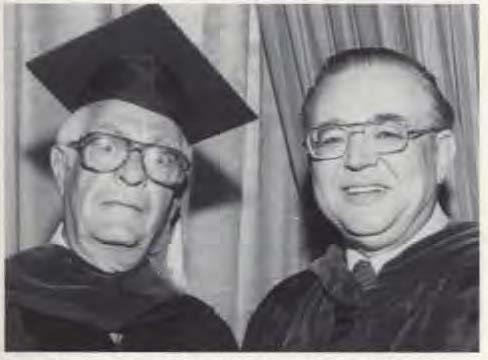
Dr. Charles E. Ziegler (V'34)was honored by the Maryland Veterinary Education Foundation. A scholarshipfund wascreated in his name. Dr. Ziegler established a mixed veterinary practice in Catonsville� Md. in 1935 and operated itfor45 years. lastfall. be was named "Citizen ofthe Year"by the Catonsville Business Associationfortm achievements, community serviceandgoodcitizenship. Dr. Ziegler is a lifetime memberoithe MVMA and past president oftheorganization. Healso served asdelegate to the AVMA in 1979: Dr.Ziegler wasthefirst MVMA member to be named"Distinguished Veterinarian."
George R. Mellilo Jr., a seniorstudent, is the recipient ofthe Bide-A-Wee Home Associa-
Dr. Henry Schneider (V'34)andDr. John R. Be/jan. provost and vicepresidentfor Academic Affairs, anddean, Hahnemann University SchoolofMedicine.
Dr. Lawrence Glkkman (V'72), associate professorofepidemiology, was oneofthe participants in the Dog Breeders Seminar at the University ofOttawain January.
Dr. James W. Buchanan, professorofmedicmc. was featured in the ani.cle''Used Pacemakersto Aid Foreign Patients with Heart Pacing Needs.''whichappeared in the August issue of Pathologst. thejournal ofthe College ofAmerican Pathologists. The articledescribes thefirst implantationofapacemaker ina dog. performed by Dr. Buchanan m 1967on a 10-yearold basenji. The pacemakerused was one implanted in a human patient who had died.
Or. Alan M. Klide (V'6S),associateprofessorofanesthesia taught a refresher course at the annual meetingofthe AmericanSocietyof Anesthesiologistsin October. Dr. Klide wasthe first veterinarian/veterinary anesthesiologist to beaskedto teach such a course beforethe society.
Dr. BetsyL. DayreU-Hart (V'83) won the ''President'sAward as Intern ofthe Year"at the Animal Medical Center. New York.
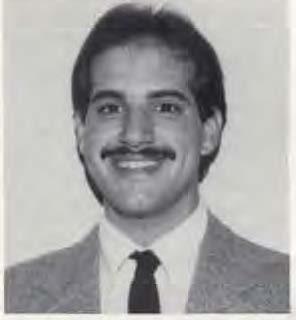
Dr. Kathleen E. Noone (V'79)was named "Veterinarian oftheYear"at the Animal MedJcaJ Center. NewYork.
Dr. Stephen J. Peoples (V'84)received the AVMAAuxiliaryStudent Senior Award.
Dr. Stephen Schiffer, director oflaboratory animal medicine, has been named adiplomate of theAmerican College ofVeterinary Internal Medicine.
Dr. Kenneth C. Bovee, Corinne R. and Henry BowerProfessorof Medicine, presented a seminaron nephrologyat theUniversityof Zuba.. Maracaibo, Venezuela. in December.
OT. Colin E. Haney, professorofsurgery. has written a bool. Veterinary Demistr)� The volume basjust been published byW. B. SaundersCompany. Philadelphia.

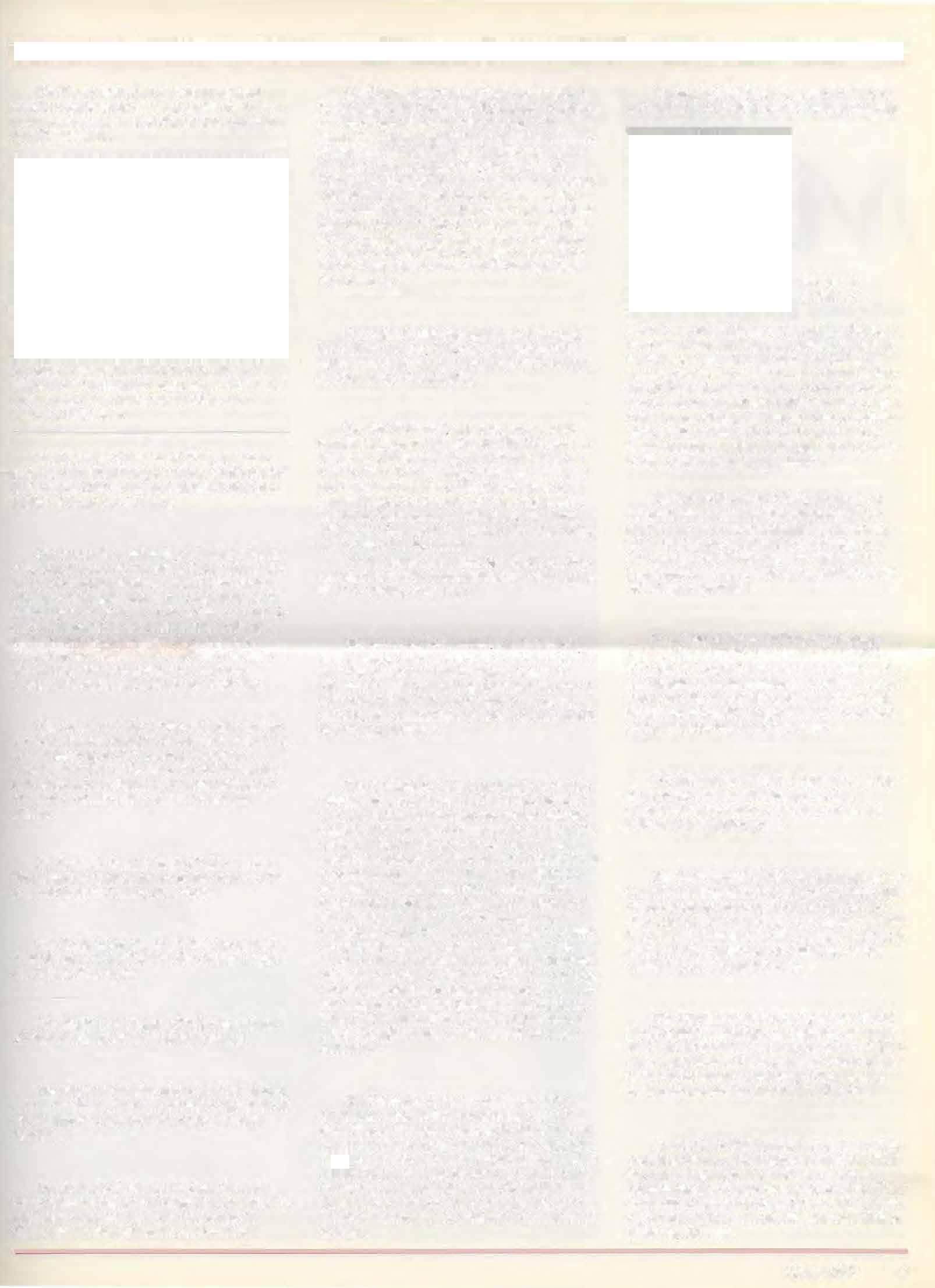
Dr. Jay P. Farrell. associate professorof parasitology, participated in the Sixth Peruvian CongressofMicrobiology and Parasitology in Cusco, Peru. The opening Lecturewasdelivered by Dr. Jorge Guerrero, adjunct professor of parasitology. Dr. Guerrero also participated in the Ninth Conference on Veterinary Research held at the College ofVeterinary Medicine ofthe stateofSao Paulo, Brazil.
As anexpertsponsored byWHO, Dr. Farrell participated in asymposium on Leishmaniasis in Cordoba. Argentina.
Or. James B.Lolc,assistant professorof parasitology, \\lasa member 01a \\liO :;ctentl1tc workinggroupon "The fn Vitro Culture of Filarial Parasites,especially Onchocerca. and of Allied Parasites."Thestudygroupwassponsored by thechemotherapyproject ofthe World Health Organization.
Or. Gerhard A. Schad, professor ofparasitology. wrote afield manual for WH0 forfield workers and admtnistratorsconcerned with the control ofhookwoml in humans. He chaired the sectionofEpidemiology and Control at the Sixth International Conference onTrichinieUosis at Quebec. Dr. Schad organized andchaired a symposium,"Ecological Perspectives in Helminth Epidemiology."at theannual meetingof the American SocietyofParasitologtStsat Snowbird, Utah. Hewasalso aninvitedspeaker onepidemiologyand control ofhuman bookwormsat the International Congress ofTropical Medicine at Calgary, Alberta. Dr. Schad and Dr. Farrell participated in the meetingofthe AmericanSociety ofTropical Medicineand Hygiene, held at Baltimore. Here Dr. Schad delivered a paper,"Predisposition ofRuman Hookworm Infection...
Dr. Robert J. Rutman, professor ofbiochemistry, received the"Front PageAward" from The Philadelphia Tribute forhiscommunityservice,hiswork on improvingthe opportunities for minoritystudents,andforhis particular activtty in establishingthe Manin Luther King Jr. Center in Philadelphia. The Philadelphia 7Tibune, the nation'soldestcontinuously published blacknewspaper,celebrated itscentennial in 1984.
George

R. Mel/i/o, Jr.
tion's Long-Sondheimer Scbolarslup. The New Yorkbased nonprofit animal welfare organization'saward provides two fullscholarships annuallyforseniorstudents-oneat the University ofPennsylvaniaand oneatCornell University.The Long-Sondheimer Scholarship is BideA-Wee's wayofacquaintingveterinary students with publicserviceearly in theircareers; it is hoped that the recipiems will practiceat a BideA-Weeclinicwhen theygraduate.
Dr. Lionel F. Rubin (V'58), professorof ophthalmology, received two grants-in�aid to support his work on ophthalmology in laboratory animals and ophthalmictoxjcology. The firstgrant,$12,500 was given by Boehringerlngelheim Ltd.; thesecond was provided by the ScheringCorporation.
Drs. John C. Simms (V'74)and Nadine Olll.Jc:) Simm�(V'78)were fe.sturcJ �.:.n ABCTV's20/20. Roger Caras.the well known author and televisioncommentator, did afeature on the day in thelifeofacountry veterinarian. It was broadcast nationaJly. RogerCaras is a member oftheSchool'sBoardofOverseers.
Dr. Richard R. Miselis, associate professor ofanatomyand animal biology, has been appointed director oftheVeterinary Medical ScientistTraining Program.
Dr. Fred Fernich (V'63) was honored by the Central Islet Psychiatric Center for his help with the pet therapyprogramat the center. Dr. Fernich providesfreeveterinarycareforthecenter's fourcats. The presenceofthe animals at thecenter has made agreat deal ofdifference in the well-beingofthe patientsthere.
The German-speaking group ofthe World Small Animal Veterinary Association presented the D. K. Detweiler Award to Or. Klaus Kolling. Theaward honors Dr. Detweiler's (V'42)contribution to veterinarycardiology.Theaward is funded by Boehringer Mannheim GmbH.
Dr. Isaiah J. Fidler, who wasan intern and a resident at Lhe School between 1966 and 1968, has beenelectedpresidentofthe American Association forCancer Research, Inc. Dr. Fidler isthe chairman ofthe Department ofCell Biology at the M.D. Anderson Hospital andTumor Institute, Houston.
Spring 1985 9
15thAnnualSymposium
than 160 dog owners and breeders attended the 15th Annual Symposium"Your Veterinarian and Your Dog" atVHUP Jan. 26. Following is a summary ofthe pre sentationsmade by faculty members.
InheritedEyeDiseases intheDogNewPerspectives.
Dr. Gustavo D. Aguirre discussed PRA and the diagnostic methods currentlyavailable. He pointed out thatthe ophthalmoscopicexamination will detectthedisease onlywhen the dog is olderwhich presents a problem forbreeds with late onset PRA. The electroretinogramwill detect the presence of PRA at an early age. ''The ERG is a powerful Lool fordiagnosingeye disease."said Dr. Aguirre. "It identifies the affected dogs while they arevery young. Theycan be removed from the breeding pool lt is also helpful in identifying carriers by using the ERG to examine puppies produced in test breedings."
He thendiscussedsome ofthecurrentwork ofLhe Inherited Eye Disease Studies Unit (IEDSU) wherehe, Dr. Gregory Acland and Dr. Lawrence Strammare searching for new methods to study, diagnoseand treat inherited eyediseases.
"We areworking with tissue cultures from cats with MPS, agroup ofdiseases caused bya metabolicabnormality,"Dr. Aguirresaid. "We are look.ing at thedisorder biochemically and structurally and hope to develop a tissue culture model for othereye diseases caused by metabolic abnormalities.''
It is known that Irish setterswith PRA have an enzyme deficiency in their rod cells which causes these visual cells to die. By studying the tissue culturesfrom the MPS catsthe researchershopetogaininformation which can be applied to PRA in the setter and other breeds. Forexample, it wasfound thattheseverity ofthe eyedisease in one type of MPS cats varies, dependingon the degree of pigmentation ofthe epithelial cells. Ifthesecellsareheavily pigmented, the disease is lesssevere. Epithelial cellsaresupport cells and theynourishand cleansetheretinal visual cells. Themembersof the IEDSU hope to determine how thepresence ofpigment slowseye disease associated with MPS. Ifthe mechanism is found then perhaps PRA in Irish setters can be better understood.
Thegroup is also examining bowcellsof the eye renew themselves. "Cells ofthe retina keep renewing themselveseveryseven days," Dr. Aguirre said. "The renewal protects the photoreceptivecellsfrompermanent damage due to excessive light, heat and oxygen." The specialized ciliated retinalcells in dogs with late onset PRA have areduced renewal rate,sometimes 50 to 60 percent of normal. This slowdown is observable longbeforethediseasemanifests itself. lt wasfound that renewal does not take place ifthe nucleus or thecell body is damaged. The researchershope to find out why the rate of renewal isslowedand whether it can be altered or prevented. They are also studying other types of PRA to determinewhether or not the renewal
of retinal cells is altered in thesediseases.
Tissuecultures ofdiseased cells also permit researchers toexplore different methods of treatment in an attempt to correct ametabolic abnormality. Theworkgoesastep further. The group is not only studyingeye cells but is also looking at tissues from other parts ofthe body. "It is possible that the metabolicdisorder, responsible forthe eye disease, is also present in cells in other parts ofthe body,"Dr. Aguirre said. "Ifthat isthe case, one could identify an animal with such an eye disease by lookingat cellsfrom otherpartS ofthe body. It would permit early diagnosisand even the identification of carrier animalsthatareclinically normal." However, it is possiblethatthe metabolicabnormalitycan only befound intheeyeand that this avenue ofresearch would not befruitful.
The group is alsostudyingthedevelopment oftheeye. Dogs andcatsareunique:whenthey are born theeyesarenotfullydeveloped This allows researchers to observethefinalstagesof eye development afterbirth. Theycandetermine

NewDiagnosticMethods:

whetherchanges take place which later in lifeare manifested as eye disease. By lookingat the developing eye it is also hoped to betterunderstand diseases ofthecornea and the lens. Per� haps one day ophthalmologists can state at which point in gestationcertain defects first becomeevident. Such information is known for congenital heart defects.
Onestartling finding by the Penn researchers ofthe Section ofMedical Genetics workingwith members ofthe Department of Human Genetics at theUDiversity of Maryland is that in test matings, the number ofaffected offspringwith lateonset PRA dependsonthe sex ofthe test bred animal. It was found tha�as expected fromclassicalgenetics, if the damwas an affected animal and she was bred ro acarrier. approximately halfthe litterwas affected and halfwas phenotypically(clinically) normal, although still carriers ofthedisease. Whenthe dam was acarrierand the sire an affected dog, surprisingly only one-third ofthe Litter was affected, two-thirds were phenotypically normal. It is not fullyunderstood why the percentage of affected offspringissmaller when the dam is the carrier but itis the ftrst time that an extraocular "marker"or trait has been associated with the PRAgene. These ftndings in miniature poodles
"CATScanandMagneticResonanceImaging."
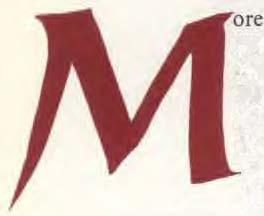
Dr.Jeffrey A. Wortman discussed the new diagnostic tools available to radiologists atthe School. While radiographystill playsan important role. newtechnologysuchas nuclear mediune(sl...liltJgraphy), ulttCl.)Onography,�-rayLOmputed tomography(CAT Scan. X-cn.and magnetic resonance imaging(MRI) permit diagnosis ofdisordersthat may not bedetectable through radiography.
Each ofthese diagnostic methods has aspecific use. Nuclear medicine permitsthestudy of anorgan and its function e.g. bone scan or thyroid scanto look at metabolic activity ofthe skeleton and thyroid gland respectively. While these arecommonlyoutpatient procedures forhuman
patients, regulationsrequirethatan animal be hospitalized for24 to 48 hours after scintigraphy. During this time the veterinary patientis housed in relativeisolationso that the body burden of rad10acth1ty isreduced to a negligible level.
Ultrasound is used with increasingfrequencytodetect soft tissuedisorders in both largeand small animals. The procedure is noninvasive. High frequency sound wavesarethe source ofimaging. The imagedisplayed on aTV monitorallowstheclinician to observean area ofthe body in motion. This is particularlyvaluable forthecardiologist. Ultrasound is also useful forevaluating abdominal organs and in

10 Bellwether
Anesthesia techniczans, Sharon Swift and Cheryl Kenney. position apatient inpreparationfor Xray computedtomography. The XCTmachine is the General Electric8800 and is locatedin the Pendergrass Radiology LaboraJOry ofthe Medical School.
mean that a greater number of puppies are required tn test mating to determine whether or not a female poodle is a carrier of PRA. In all likelihood this also applies to the Amencan cocker spaniel, the English cocker spaniel and other breeds having the late onset form of PRA.
CaninejointDisease
Dr. Charles D. Newton, associate professor oforthopaedic surgery. discussed the management and treatment of degenerative arthritis.
He pointed out that in dogs, unlike m people, degenerative arthritis is a secondary disease due to trauma or malformation of the joint. The disease involves the entirejoint, the synoviaJ fluid. cartilage and bony tissue. If a joint is injured or is developed improperly. the body reacts to the unusual wear and tear. The area becom� inflamed, bony projecttons develop and the jomt becomes stiff.
Arthritis can be treated either medicallv or surgtcally. Medical treatment consists of administering drugs. Dr. Newton explained that aspirin is still the drug of choice and can be used for most dogs. He cautioned owners to not use some of the non-steroid anti-inflammatory drugs. approved for humans, for their arthritic
detecttng pregnancy and fetal viabilit�.

X-ra) computed tomography (CAT-Scan) is a sophisticated diagnostic tool the School ha.� access to at tht: Medical School radiology research facilities. A cross-sectional image is reconstructed from computer analysis of the transmitted x-ray data recorded by �ensitive detectors. The result is a detailed study ofanatomic pathologySoftwareprogramc; altnw the view of a body area in an operator-selected plane of interest, magnification: and measurements suc:h ali length. area. and \olume. X-CT is a powerful but expensive diagnostic tool. Here at the School it has been used primaril� to detect brain lesions. h has been Invaluable in detecting the precise location of these lesions. This is particularly important in cases involving brain tumors so that biopsy and or surgical removal may now be feasible. Animals have to be anesthetized for the CAT scan procedure.

pel. "Some of these drugs are lethal to dogs,'' he said...The veterinarian should be consulted before administering an} drug to a dog."


Surgical treatment is used to correct the abnormality that causes arthritis to develop. rt will not stop the process completely but will slow progression of the disease. Dr. Newton then discussed some of the disorders causing arthritis in greater detail.
Osteochondritis Dissecans is a dtsease of the articular cartilage covering the humeral head. Isolated cases have been reported involving the distal humeral condyles and the femoral condyles. In the course of the disease. a cartilage flap is formed, which causes pain when the dog
The newest modalit} in human imaging is Magnetic R�onance Imaging (MRJ). This equipmc:nt is also available at the Medical School. 1 he size of the umt there limits its use to small dogs and cats. MRl is also a computerbased imaging system. Here. instead of x-rays. a strong magnetic field and radio waves are used to obtain an image. It has much greater soft ti��uecontra<��t than an image �encrated through I. J\ntmals also ha"e to be nnesthcttzed lor MRI.
Dr. Wortman pointed out that the value of these non-imasi»e diagnostic tools •s to allo\\ the clinician to make a more accurate diagnosis and prognosis and to develop more effective treatment planning. As the X-CT and MRl equipment is rather expensive, the cost for these procedures are higher. However. in human medicine the equipment has proven to be cost-effective.
walks. The flap may fragment. formingjoint mice. The disease is seen with greater frequency in young males of large breeds.

The underlying cause of OCD is osteochondrosis, a metabolic cartilage problem seen in many animals. Jt causes severe problems in swine and poultry.
The animal is treated surgtcally if the cartilage flap is tom. The piece is removed and the animal will rehabilitate with little trouble later in life. Dr. �ewton pointed out the OCD is not only seen in the shoulderjoint but thal it also occurs in the elbow. stifle. and hockjoints.
Another disorder discussed wru; Ununited Anconeal Process. Here a small bony process in the elbow joint becomes detached, causing instability of the joint which starts the degenerative arthritis process. The problem is seen in large breeds and-is believed to be inherited.
Surgical treatment consists of attaching the anconeal process to the ulna to stabili1:e the joint. Another procedure is to remove the anconeal process. This reduces pain but does not result in joint stability.
Hip Dysplasia is a disease of man and animals wherein the hip develops improperly. This abnormal development usually results in unstablejoints which undergo changes typical of osteoarthritis.
The disorder is treated primarily nonsurgically wah analgesics. Many young dogs at six to eight months are extremely painful during their last growth spurt. lf the pain can be controlled for this period. many never require further treatment. Quite a few animals though. appear not to have pain. even though the disease is quite advanced.

Hip Displasia can also be treared surgically. Therearcseveralprocedures.allaimedatmaking theJOtnt more stable to mLrumlZe the wear and tear and the development of arthntis.
Lcgg-Calve-Perthes disease affect primarily small breeds though it occurs occasionally in larger breeds. In affected animals the head of the femur dies, the cartilage is crushed and thejoint becomes rough. The animals are usuaJiy treated surgically, the head of the femur is removed and the dog does very well.
Another disorder causing degenerative arthritis is Cranial Cruciate Ligament Rupture. Dogs commonl} rupture the cramal cruciate ligament. due to many reasons. The resulting instability promotes osteoarthritis and severe pain and lameness are the end result tf untreated.
The ligament tear can be repaired surgically and thejoint stabilized Without direct surgical intervention, nearly all knees will become osteoarthntic.
BadBreath,Tartarand Plaque-Gingival(Gum) DiseaseintheDog.
Dr. Colin E. Harvey, professor of surgery. discussed gum disease in dogs, the most common health problem of animal� five years or older.
Gum disease is caused by plaque. a soft material that torms on the surface of the tooth. Plaque consists almost entirely of bacteria and as these proliferate, the groove between the tooth and gum is invaded. causing gmgivitis. Bacteria are always present on the surface of normal healthy teeth. As the disease progresses, the type of bacteria present changes from aerorontmued onpage 11
A rransverse section ojthe cerebrum ofan eighT year oldfemale miniowrepoodleshows comras1 enhancemem cifa left thalamic moss. Thi� was o wmvr (hemangw.�orc·omo) originarmx m the mualca\'ill'.
Spring1985 II
Gingival(Gum)Disease
continuedfrom page 11

bicbacteriatomoreharmfulanaerobicones.
Gingivitisisseenasreddeningorswellingof thegums. Insomeanimals,thegingivarespond totheinsultoveralongperiod bybecoming thickened:thegumtissuegrowsuparound the teeth,creatingpocketswherefoodparticles remain. fn otheranimals,thegumsrecede exposingbone. Astheboneis resorbed,apocket developsbetweentoothandgumwherebacteria nourish.
Almostalldogsfiveyearsorolderhave measurablegumdisease,sometimeswithoutthe ownerbeingawareofanyabnormality.The mostcommonsignisbadbreath. Dogs rarely loosetheirappetiteasaresultofgumdisease, evenwhentheyhaveamouthfuloflooseteeth. Catsaremuchmorelikelytobepainful.
Diagnosisofgumdiseaseismadebyinspection ofthemouth.Theextentofthediseaseis assessedbyablunttippedprobe;this isusedto
measurethedepthofpocketsandtoscrapethe sideofthetoothtotestforadherenceofplaque orcalculus.Anormaltoothhasapocketdepth ofnomorethan2to 3 mm.
Gumdiseasecanbeexacerbated bymany conditions,includingmalnutritionorother generaldebility(includingpregnancyorlactation),endocrineabnormalities,immunosuppression,etc.
Treatmentisaimedateliminatingplaque, restoringthegum-toothjunctiontoasnormala conditionaspossible,andfollowingupwitha preventiveprogram.Mostanimalspresented withbadbreathduetogumdiseasewillrequire teethcleaningunderanesthesiaasthefirststep.
Teethscalingisdesignedtocleanthesurfaceofthetooth,notonlythecrownbutalso theareabetweentoothand gum.Thisisthe mostimportantareaasherethebacteriaflourish. Cleaningisperformed with ultrasonicand handinstruments.Aftercleaningtheteethare polishedtocreateasmoothsurfaceto which bacteriacannotadhere.
PracticingAbroad
ALetterFromI.ima, Peru
Lima,Peru,withapopulationof6million, isthelargestcityinwhichIhaveeverlived. Whenwemovedthere 18monthsago,Iwas optimisticaboutworkpossibilities.Thereisa veterinaryschoolhere,andseveralveterinarians trainedintheUnitedStates.
Peruvians,onthewhole,areaveryformal butwarmpeople. Aswearestillwiththediplomaticservice,I spendafairamountoftimeat socialfunctions-discussingtheweather,the maids,schoolsandshoppingwithPeruvian women.Itisalmostimpossibleformetobreak beyondthesetopicswitheventhewomen, let alonethemen.Themenarereluctanttohavea seriousconversationshouldIevenbewithinearshot.Therefore,you mightbeabletoimagine howdifficultithasbeenformetoestablish myselfprofessionally.
The UniversityofSan Marcoshasthebest veterinaryschool in·thecountrybutithasno moneyandthereforeooequipmentorsupplies. ItsfacilitiesareaboutthepoorestI haveseen anywhere.
Afterspendingagreatdealoftime"observing.,atSan Marcosand inseveralprivatepractices,I agreedtoworkwithDr.JoseBrener,who did hispost-doctoraltrainingin Scotland. We runasmallanimalclinicoutofoneroomand
makefrequenthousecaiJs. WhenIstartedthere wasnomicroscope,noophthalmoscope,nogas anesthesia,noX-raymachine.Nowwehavea microscope-mine.Wealsohaveadesk.atable, alargelamp,abasicsetofsurgeryinstruments andketamine.Weworktogetherandthekeyto therelationshipisthatheholdsanimalsforme. And Ibold animalsforhim. Hehasdevoured mylibrary; hismostcurrentbooksarefromthe Sixties. MailservicetoPeruisnotthebest either.
Mostly I seeEnglish-speakingclientsfrom the United StatesandCanada. Myofficevisit feesrunhighbyPeruvianstandards:Icharge theequivalentof$6.Myhousecallsareoutrageousat$10,butNorthAmericansareusuallywillingtopay.Astheannualrateofinflationiswell over 100 percent, manysuppliershavestartedto chargeindollarequivalentsforimportedproductsandmedications.Astheexchangerate changesdaily,sodotttecostsofmyvaccinations andmedications.Inmyfirstyearofpractice,I lostenoughmoneythatIwasbeginningtofeel likeveterinarymedicinehad becomeanexpensivehobby.
IhaveraisedmysurgerypricesandI'm finallyintheblack.But I wonderaboutthe averagePeruvianveterinarianwhoistryingto
Whenthepocketdepthisgreaterthan 5 mm,surgeryisnecessarytoeliminatethepocket. Sometimesthediseaseissoadvancedthatthe toothhastobeextracted.Thisisparticularly usefulincats,whereseveregumdiseasecan causecompleteinabilitytoeatordrink,and whereresultsofconservativetreatmentareoften poor.
Dogownerscanpreventgumdiseasein theirdogs.Thecleanandsmoothteetharekept ingoodconditionbyregulardailycleaning.This canbedonetosomeextentbyfeedingdryfood. orbyencouragingchewingontoysorrawhide strips. Adailybrushingwithasoftchildstoothbrushismuchmoreefficient.Avoidhuman toothpastesbecauseofthedetergentthey contain-dogsdonotlikethefrothing.
Dr.Harvey'sadvicetotheaudiencewasto get atoothbrushforeverydogandstartbrushingonceaday.However,theteethshouldalso bethoroughlycleanedtocontrolanygumdiseasealreadypresent.
Helma Weeks
survive.He(therejustaren'tany"she's"inprivatepractice)can'tbemakingmorethanafew hundreddollarsamonth. Recently,someone cametomeforasecondopinionconcerningthe treatmentofahipdislocation.ThefirstveterinarianhadgiventhemanaUinclusiveestimate of$60todoafemoralbeadandneckresection. I havetowonderaboutthequalityofthework atthatprice.
IsupposemyproblemisthatI'mstilllookingforthelifeIleftintheUnitedStatesina thirdworldcountry.Thebasicconditionsforlife hereareunacceptabletome.I knowthingscan bebetter.Wbyaren'tthey?ButhowcanIexpect apeoplewholethundredsofchildrenstarveor diebecauseofnomedicaltreatmenttocare properlyfortheiranimals?Eventhewealthy don't.
So I createmyown"littleAmerica"and practiceasbestIcan.I haverealizedthatf'U makenochangeshere,otherthantoimprove Dr. Brener'slibraryandequipmentsupply,but atleastrhavedonesomething.
Susan D. Morgan (V78)
(Editor's note: In September, Dr. Morgan left Peru to return to Portland, OR. anda small animalpractice.)

12 Bellwether
APopularExhibit
MAN AND ANIMALS: LIVING, WORKING AND CHANGING TOGETHER, 1he exhibit a/ the University Museum ofthe University ofPennsylvania, ispopular with the public and the media. Recentlycast members of the musical CATS, the magicai "Mr. Mistoffelees"and "Cassandra"(the Egyptian Cat) visited comemporaryfriends and ancienrfeline relatives during a trip to The University Museum ofthe University ofPennsylvania on which theyshot a public service announcementfor the Museums current exhibition MAN AND ANIMALS: UVING, WORKING AND CHANGING TOGETHER. Pictured,from left: Dr. Donald Patterson, Charlotte Newton Sheppard Professor ofMedicine and Chief, Section ofMedical Genelics, School of Veterinary Medicine, University ofPennsylvania; Susan Catherwood (Mrs. Cummins Catherwood, Jr.), Chairman of the Board ofOverseers, The Universily Museum; Lex Carlin, Manager. the Forrest Theatre; Barry K. Bernal ('Mr. Mistoffelees"), CATS; Steve Smith, owner, Videosmi:th; Jessica Northrup ('Cassandra"), CATS; Dr. David O'Connor, Associate Curator ofthe Egyptian Section, The University Museum; and Phoebe Resnick, Public Information Officer, The University Museum.
The Museum also hosted the Second Annual lee Sculprure Competition on Jan. 26. Amongjudges were Charles A. T. O'Neill, executive vicepresident ofthe American Kennel Club andJoseph F. Skelley (V'47), associate dean.
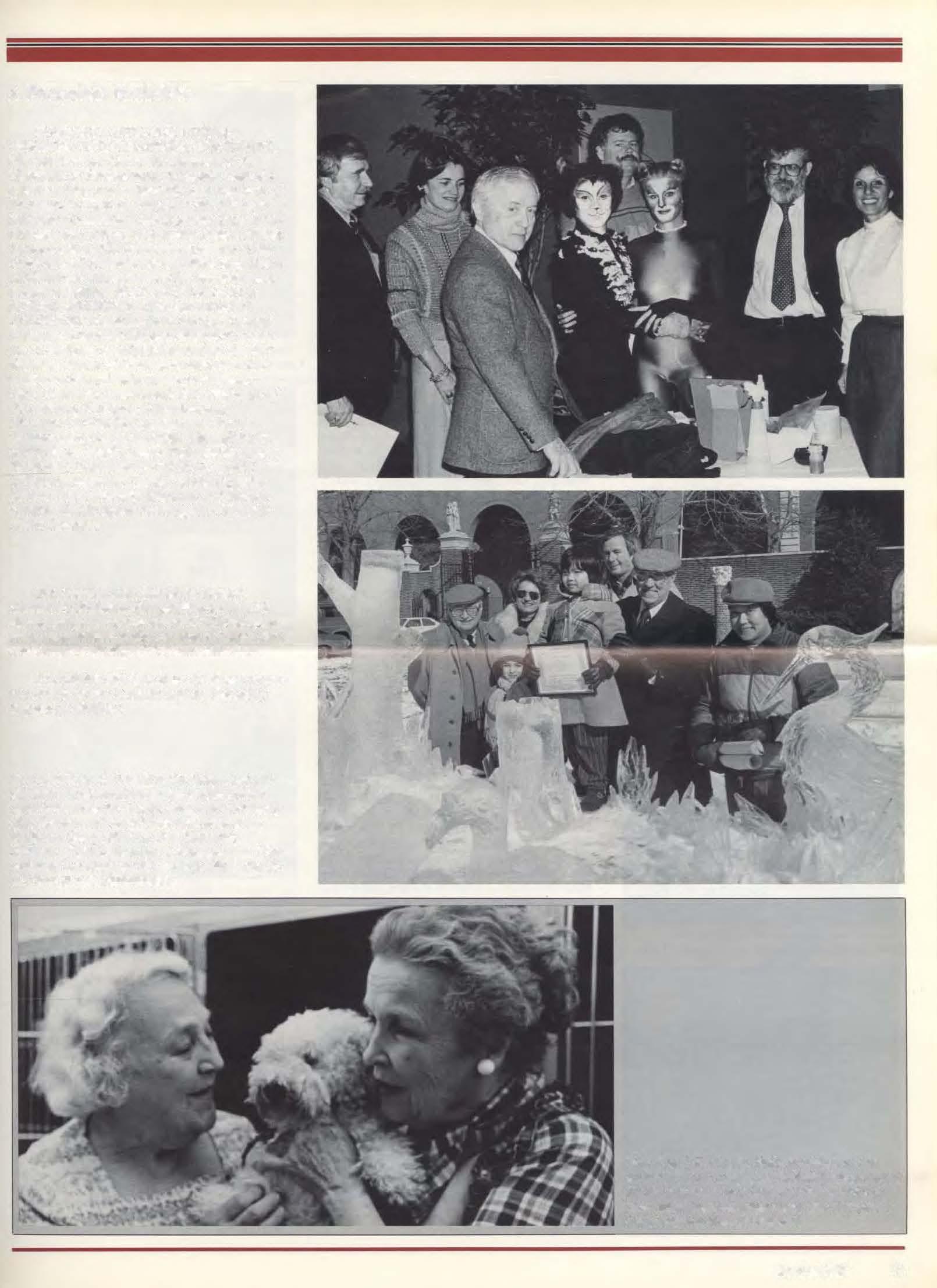
The exhibit will close June 30. It was organizedjointly by the Museum and the School of Veterinary Medicine.
Mr. Charles A. T. O'Neill (left),judges andparticipants arepicturedhere with thefirstplace award winner in the "Large Sculpture"category (fourfigures and over) in the 2nd Annual lee Sculpture Competition at The University Museum ofthe University ofPennsylvania. The sculpture was designedby the Wyndham Franklin Plaza Hotel, Philadelphia.
Mrs. Virgil H. Fra=ier (left). president ofthe Animal Rescue League ofPhiladelphia arrangf!d for the treatment ofa bauereddog at VHVP.
Spring 1985 13
Mrs. Hebe .&ldwin (right) took che dog after it had recoveredfrom its injuries.
Our ·'thanks"to the 500 practitioners and 45 e�hibitors who attended the 1985 Penn Annual Conference on Jan. 30 and 31 at lhe Adam's Mark Hotel in Philadelphia. Forty speakers presented lectures over the two-day conference, including Dr. FrankJin Loew, who discussed the "History. Science and Politics of the Use of Animals in Research." Dean Robert R. Marshak hosted a reception for all participants Jan. 30 that continued well into the evening. Mark the 1986 dates for the 1986 Penn Annual Conference on your calendar: Wednesday. Jan. 29. and Thursday. Jan. 30, at the Adam's Mark.
Next year will be even better!!
Watch your mail for the Spring 1985 Continuing Education Program. Large and sm.all animal courses are planned for April and May.
Centennial Awardof Merit
Dean Robert R. Marshak presented 36 Centennial Awards of Merit at a special ceremony on Dec. 8 in Philadelphia. Among the honorees were nine Pennsylvania legislators and state officials who were cited for their outstanding support ofveterinary medjcioe.
Honored were Walter Baran, Frackville, the secretary ofgeneral services and executivedirector ofthe General State Authority: Penrose Hallowell. Ottsville, secretary of agriculture; Representative Samuel W. Morris (D-155), Pottstown� Representative Carmel A. Sirianni (R-Jll), Montrose; Senator Patrick Stapleton (D-41), Indiana� SenatorJohn Stauffer(R-19), Phoenixville; Senator "'oah W. Wenger (R-36), Ephrata; Senator Roy W. Wilt (R-50) Meadville: Robert C. Wilburn. former Pennsylvania secretary of education; George B. Wolff, Harrisburg, and Alvin M. Myers, Jr.. Camp Hill, the director of governmental relations for the Pennsylvania Farmers Association.
Awards also were presented to a group of researchers and sc1entists from this country and from abroad for their outstandingcontributions to veterinary medicine.
Those recipients were Dr. Jonathan Adler, Jerusalem. Israel: Dr. Duane T. Albrecht, Denver� Dr. Robert B. Altman, Franklin Square. NY: Dr. Uri Bargai, Shimstron. Israel; Prof. Ian Beveridge, Cambridge, England: Dr. Frank Bloom. Miami, FL; Dr. Daniel Cohe� Tel Aviv, rsrael; Prof. 0.0. Dipeolu. lbadan, Nigeri� Dr. Stephen Ettinger, Los Angeles.
Also, Dr. LawrenceJ. Hutchinson, University Park, PA: Dr. William F. H. Jarrett. Glasgow, Scotland; Dr. William J. Kay, New York; Dr. Edwin J. Kersting, Manchester. Ct.: Dr. Robert W. Kirk, Ithaca. NY; Dr. Harry Magrane, Mishawaka. IN; Dr. Roy Mack, Surrey, England: Dr. John R. McCoy. Piscataway. J; Dr. Benjamin S. Pomeroy, St. Paul, MK; Dr. Wayne H. Riser, Gainesville, FL; Dr. Harry Rubin, Berkeley, CA; Prof. Dr. Heinrich Sporn, ZUrich Switzerland: Dr. James H. Steele, Houston� D�. Joseph M. Stoyak(V'52), Springfield MA: Dr. Gus W. Thornton. Boston, and Prof. Eberhard Trautvetter, Berlin, W-Germany.
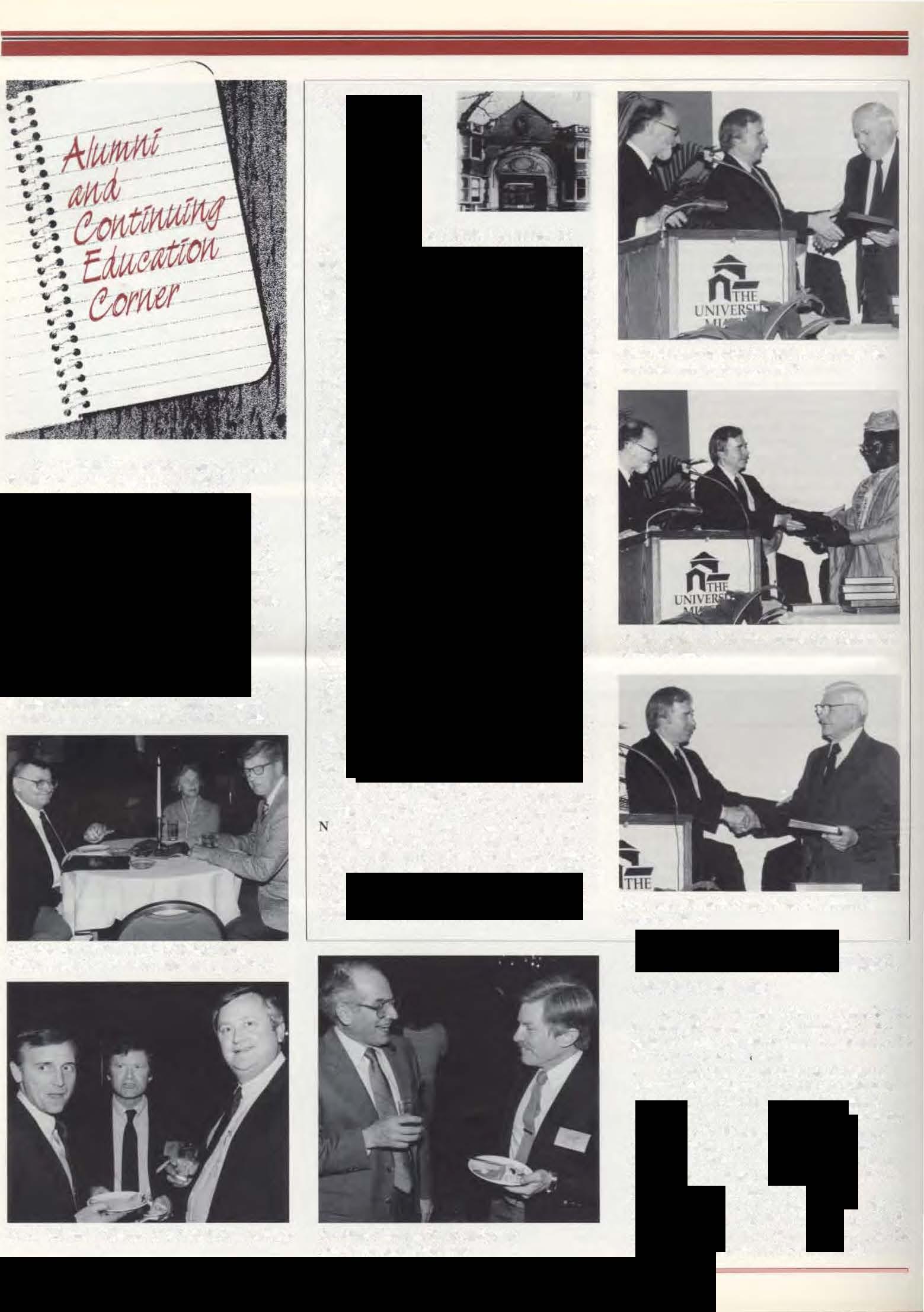

CentennialDistinguished ServiceAward
At a special luncheon Dec. 18, Dean Robert R. Marshak presented the Centennial Distinguished Service Award to School employees with 18 or more years of ervice.
The recipients were: Richard S. Barker. Thomas Barker, James Lero} Bruce, Clarence Chapman, Vera Duncan, Betty T. England. Cathryn E. Fluellen, WiUiam Garman, Rosetta Goss. Mary R. Hammond, Harry E. Hance, Suz:anne Hindman, Alice Holton. EvelynV. Huntington. Ralph lannuvj. Harriet L. !zenberg, Raye Johnson, Lynne Klunder, Helen J. Linwood, Larue A. Manning. Joseph J. McGrane, Derek W. Muncey, Grace V. Pinhak. George Pournaras, William R. Schnarr, Jane F. Shirer, Sarah B. Smith, Wilbert Underwood,Dr. Marvin J. Silverman and Renata Worth.
Dr. Norbert McManus(V'47)(/eft). Mrs. McCullough, Dr. John D. McCullough (V'43)
14 Belhtetlrer
Dr. A. Cleveland Brown (V'59)(right)andfriends
Dr. Max Herman (V'59)(left) and Dr. lAwrence Hutchinson
State Senator Patrick J. Stapleton is presented the CentennialAwardofMerit
Professor 0.0. Dipeolu receives the Centennial AwardofMerit
Dr. Wayne H. Riseraccepts the Centennial AwardofMerit
AlumniDay,1985willbe heldatNewBoltonCenter onSaturday,May18,1985.
Meet the Dean and Faculty over coffee, attend the Annual Meeting and partake in a buffet luncheon. The afternoon schedule includes rours of New Bolton Center and the Brandywine River Museum. Dean Marshak will host a reception at 6:30 P.M. at the Wilmington Hilton, followed by a dinner for all veterinary alumni. Those classes celebrating their reunion years (any class graduating in a year ending with a 5 or 0-e.g. 1945, 1960) will be seated at the same table.
So if you can't get away on Saturday, May 18 during the day, we hope you will be able to join us Saturday at 6:30 P.M. for dinner with
Resources
NewBoltonCenter
GENERAL SERVICES
The area code for New Bolton Center is 215. Arrangements for hospitalization or emergency services can be made by calling 444-5800. Inpatient and outpatient referrals should be directed to specific sections. For Bovine Surgery, call 444-3595. For Equine Surgery call 444-320 1.
Equine Outpatient Clinic
Open Monday through Friday, 9 a.m. to 5 p.m., and accepts patients without prior referral. Call Dr. William Moyer, 444-5800, ext. 405 or 406.
Field Service
Provides routine health care and emergency service for farm animals and horses in the surrounding community: Call 444-0900.
SPECIALTY SERVICES
Cardiology
Clinic day: Tuesday and Wednesday, 9 a.m. to 5 p.m. Services include cardiac consultation, electrocardiograms, phooocardiograms, echocardiograms, and cardiac catheterization. Complete work-ups for poor racing performance can also be executed, including respiratory evaluation, submaximal exercise testtng, endocrine evaluations, endoscopy, cardiology, and lameness evaluations. Work-ups can be scheduled for other days. Call (215) 444-5800, ext. 359.
Nutrition
Nutritional services, for the livestock industry, are offered in cooperation with referring practitioners or the New Bolton Center Field Service. Call (215) 444-5800, ext. 3 I6.
Radiology
Radiology, Monday through Friday, 9 a.m. to 5 p.m. Only referral cases accepted. Call 444-5800, ext. 198.
Reproduction
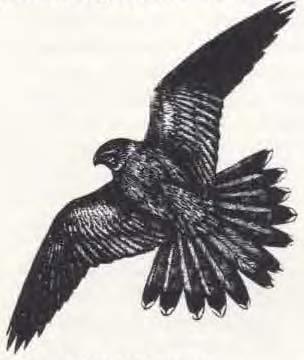
Fertility Clinic: The Georgia and Philip Hofmann Research Center for Animal Reproduction provides fertility examinations for stallions, mares and other large animals. Call 444-5570.

DIAGNOSTIC SERVICES

Clinical Microbiology Laboratory
This laboratory is located in the Myrin building, Room 103, and provides a number of diagnostic services for the practitioner� isolation and identification of aerobes, fungi, salmonella, CEM (not for export purposes) organisms; microbiological evaluation of environmental, surgical, and postmortem specimens; mastitis specimens;
your classmates, and an evening of dancing to the music ofSteve Michaels and his Orchestra. Reunion year-OR NOT-plan to eat, drink and be merry at the VETERINARY ALUMNl DINNER DANCE!!
Calendar
Apri1 27 Spring SCAVMA and PVMA Picnic. New Bolton Center
May 18 Alumni Day, New Bolton Center May 20 Commencement
July 23 to 26 AVMA Annual Meeting. Las Vegas
ALUMNl-BeUwether would like to hear from you for a new series on the diversity of our alumni.
Do you make house calls?
Do you specialize in unusual exotics?
Are your patients rare animals?
ls your practice in a foreign country?
Share your experiences and drop Bellwether a note. The Newsmagazine can be reached by writing to: Bellwether, School of Veterinary Medicine, 3800 Spruce Street. Philadelphia, PA 19104.

AUXILIARY SERVICES
The Large Animal Hospital bas. on call certain specialty services at the Philadelphia campus, such as dermatology. neurology, and ophthalmology. Investigators .in research units at New Bolton Center, such as the Comparative Leukemia Studies Unit. also are available for consultation. For information call 444-5800.
VHUP
APPOINTMENTS: 215-898-4680
(Behavior appointments scheduled by department only-898-4525)
antimicrobial susceptibility testing, direct gram stains. acid-fast and KOH (fungal) stains; preparation of bacterins, and certified EIA (Coggins) testing. Specimens should be sent directly to Microbiology, New Bolton Center. For general information and specimen and special handling procedures, cal1 444-5800, ext. 156, 157, or 159.
Clinical Laboratory Medicine
This laboratory provides routine hematologic, urine and fecal analysis. Profile studies (12 separate assays) are available at reduced charges. A limited number of tests are available during evening and weekend hours. For a detailed listing of tests, fee schedule, and preferred collection system, can (215) 444-5800. ext. 250.
.Large Animal Pathology Laboratory
This laboratory offers necropsy and biopsy services. Biopsies should be mailed to the laboratory. Animals for necropsy must be accepted by the duty pathologist. Call 444-5800, ext. 211
Cooperative Poultry Diagnostic lAboratory
Monday to Friday 8:30a.m. to 4:30 p.m. This is a University-state cooperative laboratory providing diagnostic and consultation services for poultry, game birds and pet birds in the following areas: serology, bacteriology, virology, and pathology. Farm visits may be arranged. Call 444-4282.
Diagnostic Assistancefor Herd Problems
Clinicians are available to assist andI or consult with veterinarians in the evaluation of difficult or unusual problems. For information call Dr. Robert Whitlock, 444-5800, ext. 321.
Endocrine LAboratory
Assays and consultation on reproductive, thyroid, and adrenal hormones. Call Dr. Marolo Garcia, 444-5800. ext. 202.
Cytogenelics Laboratory
Chromosome analysis. Call Ms. Lynne Klunder, 444-5800, ext. 204 or 110.
EMERGENCY ROOM: 215-898-4685 (24 hours a day-7 days a week)
CLINIC DAYS
Cardiology: Wednesday, Thursday, Friday
Dental: Monday
Dermatology: Tuesday thru Friday
Exotics: Evenings (days vary)
Medicine: Monday thru Friday
Neurology: Wednesday (Other days be special a_-rangement with referring veterinarian)
Oncology: Monday
Ophthalmology: Monday
Orthopedics: Monday, Wednesday and Friday (This section accepts appointments after the referring veterinarian has called to explain the case).
Medical Genetics/ Pediatrics and Reproduction: Monday and Tuesday
Soft Tissue Surgery; Monday thru Thursday
WILDLIFE SERVlCE offers veterinary care for unowned wild animals such as pigeons, hawks. owls, squirrels, rabbits and groundhogs found abandoned and injured.
CalJ 215-898-4680 during regular hours (Monday thru Friday. 9:00 a.m. to 4:30 p.m.)
Al other times, call 215-898-4685
Spring 1985 15

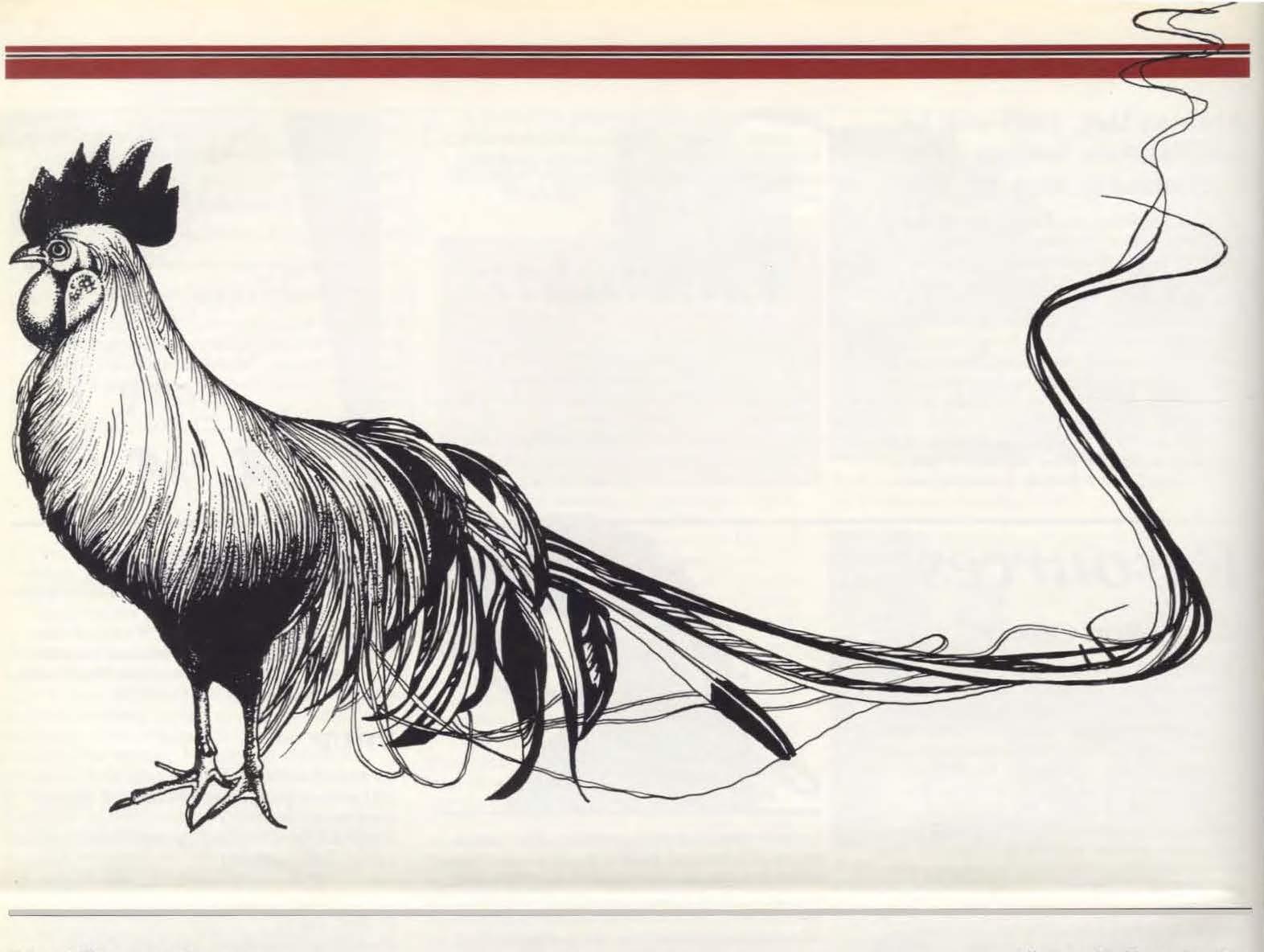
University of Pennsylvania School of Veterinary Medicine 3800 Spruce Street Philadelphia, PA 19104 Nonprofit Organization US Postage PAID Philadelphia, PA Permit No 2147 Address correction requested
Bell"W"ether





















































